PART ONE:
A BRIEF LOOK AT PAUL ROBESON'S EARLY LIFE
Paul Leory Robeson was born on April 9, 1898 in Princeton, New Jersey. His father was William Drew Robeson who had been born into slavery. William escaped a Southern Plantation to became the Minister of the "Witherspoon Street Presbyterian Church" from 1880 to 1901. He was also a direct descendant of the "Ingo people" that came from modern day Nigeria.

Paul's mother was Maria Louisa Bustill Robeson> She was raised as a Quaker and her ancestry came from both the "Ingo people" and the "Lenape Native Americans". Who are now part of the Delaware tribe. Mria was a teacher who had attended the historically black "Lincoln University" in Oxford, Pennsylvania.
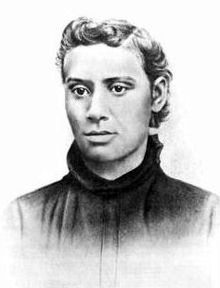
Paul was the younger of five children: brothers William Drew, Jr., Reeve, Ben and sister Marian. As a young man he would fill in at the church when his father was called away. Paul Robeson's education included attending "Somerville High School" in Somerville, New Jersey.
Paul Robeson met two challenges when he went to college at what was then called "Rutgers College" in 1915. The first challenge was that he was only the third African-American student to attend "Rutgers" and the only one at the time. He wanted to try out for the "Rutgers Scarlet Knights Football Team". Paul was resolved to make the team and after breaking his nose from what was described as "Excessive Play" by the White members. The coach and the players welcomed him to the team.
Below Paul Robeson is on the right with fellow African-American football player Fritz Pollard. Fritz would go on to become the first African-American Football Coach in the "National Football League".

The first signs of Paul Robeson's activism was seen during college during World War 1. In an oratory class and to those others, on campus, who might listen. Robeson brought up how African-Americans were fighting and dying for the United States, but did not have the same rights as Whites. This became the basis for the first of four oratory awards he would receive. Paul Robeson, became the first African-American to letter in both his junior and varsity years. He left "Rutgers" "Phi Beta Kappa" and a member of the college's honor society.
After "Rutgers" Robeson started law school at the "New York University School of Law", but left it as he felt "Uncomfortable", as an African-American there and moved to"Columbia University". Three events occurred at this time.
The first found Paul an assistant football coach at "Lincoln University". Which give him a small income. Known for his singing the second event saw Paul Robeson performing at the opening of the Harlem YMCA. While, number three happened at "Columbia". Where Paul Leroy Robeson met Eslanda "Essie" Cardozo Goode. .
The two would be married in August 1921 and after their graduation. Essie would become a noted anthropologist, author, actor and civil rights activist. She would eventually become her husband's business manager until her death in 1965.
It was Essie that was able to get Paul to go on stage for the first time and that would lead to an off Broadway play singing in the chorus.
Below Paul, Essie and their son Paul, Jr. Who like his parents was a Civil Rights activist.

PART TWO:
LEGITIMATE THEATER AND MOTION PICTURES 1922 TO 1936
After graduating in 1922 Paul Robeson started to look for work with a law firm, but by the end of 1923, after all the work he put into getting a law degree, he couldn't find real work due to the widespread racism in the profession.
Acting and singing became Paul Robeson's profession as Essie's income supported them. Paul was given the leading role in playwright Eugene O'Neill's 1924 "All God's Chillun Got Wings". Some biographers have the month incorrectly stated as December, but they play premiered on March 17, 1924 at the "Provincetown Playhouse in Greenwich Village. That opening was delayed, because of a small fight over the plays subject matter "Miscegenation".
Because of the delay in performing the new play, which may have contributed to the misstated month, O'Neill cast Robeson in a revival of his "The Emperor Jones". Without the support of the playwright and his wife. Paul might not have performed what is almost a 90 minute soliloquy.
In fact it was his wife's ambition that pushed the new actor to greater heights. After these two roles Essie quit her job and became her husband's full time manager. While, at this time, he was very indifferent to the acting profession. She saw his future.
Body and Soul released November 9, 1925
It was Essie who got her husband the lead in his first motion picture "Body and Soul". This "Race" film was written, directed and distributed by Oscar Micheaux. Although his company was short lived. Micheaux is considered the first African-American feature film maker.
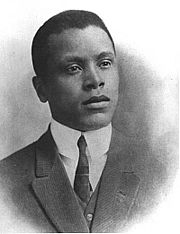
Above Oscar Micheaux
Robeson had dual roles as twin brothers. One good and one bad. The bad brother has escaped from prison and takes on the persona of the "Reverend Isaiah T. Jenkins" in the predominantly African-American community of Tatesville, Georgia. His brother is named "Sylvester".
The fake reverend falls in love with a member of his congregation, "Isabelle", portrayed by Julia Theresa Russell, who is in love with his brother "Sylvester".

Above "Isabelle" and the fake reverend.
Another convict comes to town and joins the reverend in robbing the congregation starting with "Isabelle's" mother "Sister Martha Jane", portrayed by Mercedes Gilbert.
The fake reverend steals "Sister Martha Jane's" money and convinces "Isabelle" to take the blame. After which she rethinks her sin and flees to Atlanta. "Isabelle's" mother arrives and her daughter reveals something else she was hiding. The reverend raped her and after her confession dies. "Sister Martha Jane" confronts "Reverend Jenkins" in front of his congregation. He flees into the surrounding woods and kills a man who was pursuing him.
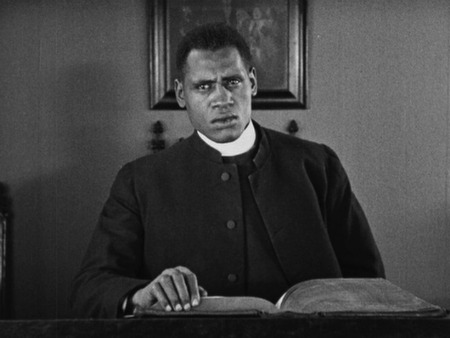
The film ends with "Isabelle's" mother, who had always opposed her marrying "Sylvester", awakening from a dream and realizing her daughter is safe and alive. The whole story, to this point, was her dream and she gives "Sylvester" and "Isabelle" money to start a life together.
How long the directors cut of the picture was is unknown. We know it ran to nine silent reels, but the "Motion Picture Commission of the State of New York" made Oscar Micheaux cut it down to under five reels, because they deemed the picture "Immoral", "Sacrilegious" and would "tend to insight to crime".
His acting had moved Paul Robeson into an elite circle and his singing brought him to the attention of African-American composer and pianist Lawrence Benjamin Brown. Brown composed many spirituals and the two men started appearing together. As a result "Victor Records", before they combined with RCA to form RCA-Victor Records, signed Paul to a contract and he recorded his first record of African-American Folk Songs and Spirituals.

Camille: The Fate of a Coquette released sometime in 1926
This was a strange 33 minute short produced, directed and using home movies by Ralph Barton. Barton was a celebrity cartoonist known for his caricatures. The short was very loosely based upon Alexander Dumas' 1848 "La Dame aux Camelias". In it Robeson was supposed to be Dumas and others appeared in different roles. It is who was seen and not what was photographed that makes this short so interesting. Ralph Barton's cast included, among others, actor Charlie Chaplain, writers Sinclair Lewis, W. Somerset Maugham and Theodore Dreiser, attorney Clarence Darrow, actresses Ethel Barrymore and Dorothy Gish and movie director and acting coach Max Reinhardt.In all Barton had 52 celebrities appearing in named character roles.
In the same year a straight version of the Dumas novel, not to be confused with the above, starring Norma Talmadge and Gilbert Roland was released.
On November 2, 1927 Paul Robeson, Jr., was born and while touring with Lawrence Brown. Paul received a wire from his wife's mother, against her wishes, that Essie wasn't doing well after the birth and he immediately returned home. The two spent December together until she recovered completely and Paul returned to the tour.
In 1928 Paul Robeson portrayed "Joe" in a London Production of Jerome Kern and Oscar Hammerstein II's musical version of Edna Ferber's "Show Boat". His rendition of "Ol' Man River" was recorded and became a major International recording. Some British Black critics, at the time, were not pleased with the production as "Joe" and the other Black's in the cast were called "Nigger". In fact the opening song "Cotton Blossum" originally contained the line:
"Nigger's all work on de Mississippi", but today it is usually sung as "Here we all work on de Mississippi".
The London White audiences loved the musical. During the run Paul Robeson was called to Buckingham Palace for a command performance.
Below one of the two different 1928 recordings of Paul Robeson's "Ol' Man River" by "Victor".

Borderline released October 13, 1930
This silent Swedish made motion picture was never released in either Sweden, or the United States. It was first released in the United Kingdom.
The picture starred both Paul and Eslanda Robeson. His role was originally described as "Pete-A Negro". Her role was originally described as "Adah-A Negro Women".

The story is about a Negro women having an affair with a White man. His wife can cope with the idea him having the affair, but not that she is Negro. This causes the wife to slowly go mad. The film also shows the effect on the Negro women's own husband.
As with many Swiss films, such as 1967's "I Am Curious Yellow", the subject matter was controversial for its time. This film is now recognized as being one of the first, if not the first, to actually attempt to tackle inter-racial relations in an honest way. Compared to stereo typed early silent films even by African-American writers, producers and directors.
Also in 1930 Paul Robeson portrayed, for the first time on stage, William Shakespeare's "Othello" opposite Peggy Ashcroft as "Desdemona".

According to Paul Robeson, Jr. in his 2001 biography "The Undiscovered Robeson: An Artist Journey 1898-1939". His father said this performance demonstrated the real artistic work "men of colour" could accomplish rather than:
be a propagandist and make speeches and write articles about what they call the Colour Question.The Emperor Jones released September 29, 1933
The screenplay for this United Artists feature was by DuBose Hayward./ Who added to Eugene O'Neill's play a backstory and several new characters.
The basic back story has "Brutus Jones", Robeson, at a prayer meeting in which the minister asks the congregation to pray for him. "Brutus" has just been given the lucrative job as a"Pullman Car Porter". He proudly shows off his new uniform to everyone and his girlfriend "Dolly" played by Ruby Elzy. The prayer meeting is an opportunity to insert a spiritual song by Paul.

Between working the trains "Jones" becomes corrupted by "Evil" Harlem women and crap games. He accidentally stabs his friend "Jeff", Frank H. Wilson, who introduced him to the beautiful "Undine" played by, Fredi Washington. "Brutus Jones" stands trial for the stabbing and is sent to a chain gang.
He will escape and end up the "Emperor" of a small Caribbean Island as in O'Neil's original play.. There his power goes to his head as the revision of the play is shown to the audience.
The picture also uses the word "Nigger" throughout as did Eugene O'Neil's original play. However, whereas Paul Robeson and the other actors apparently did not object to the word in the context of the story. When the original play opened in 1920 the original actor Charles Sidney Gilpin, below, strongly objected and changed the word to "Negro".
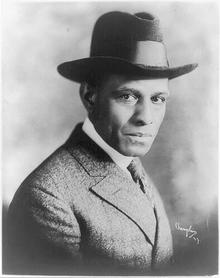
The picture was a box office failure. Depending on where it was shown in the United States, or in Foreign countries the running time changes. The film was released at 80 minutes, but edited versions had running times of either 76, or 72 minutes.
The Hayes Censorship Office strictly forbid scenes of violence between Black and White actors. So one of the cuts made was of "Brutus Jones" attacking a sadistic White prison guard. This left a visible gap in the story line of why he escaped.
In early 1934 Paul Robeson enrolled in the "School of Oriental and African Studies" of the "University of London" in the U.K. He wanted to embrace his ancestry and his course of study included Phonetics, Swahili and other African languages. Paul wrote a term paper entitled:
I Want To Be AfricanAbout this time, depending upon whose biography you read, Paul and Essie were having martial problems over his many affairs. What the details are varies by author.
In 1934 some of the friends Paul Robeson had made, in the anti-Imperialism movement, suggested he might want to visit the Soviet Union. Paul and Essie took them up and was invited to meet Russian Motion Picture Director Sergei Eisenstein, 1925's "Battleship Potemkin" and 1927's "October: Ten Days that Shook the World". On their way to Russia was a stopover in Berlin and Paul experienced, first hand, the Nazi Regime's racism. In a January 15, 1935 interview in the "Soviet Worker" Paul Robeson is quoted as saying about the Soviet Union
Here I am not a Negro but a human being for the first time in my life ... I walk in full human dignity.His views toward the Communist Party started to take form. Then came a movie supposedly about racial tolerance.
Sanders of the River released April 8, 1935
Paul Robeson specifically took on the role of "Bosambo" in the London Film company's "Sanders of the River". because the screenplay was about racial tolerance and understanding.
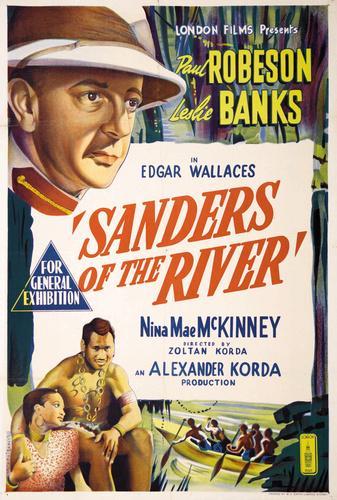
This was a major production produced by Alexander Korda and directed by his brother Zoltan. The screenplay was based upon a series of stories by writer Edgar Wallace. The excellent Leslie Banks portrayed "Commissioner R.G. Sanders" a major character in a popular U.K. series of novels.

The character of "Bosambo" is a very literate and well educated Nigerian chief. He is an ally of "Sanders" who wants to rule, for the British Empire, "Colonial Nigeria" in a fair and just way. Leslie Banks is in the center of the following still.

When "Sanders" goes on vacation back to England. A rumor that he died there is spread to stir up the tribes in revolt. He returns and with "Bosambo" they fight the uprising led by "King Motolaba" played by Toto Ware. "Bosambo" kills "Motolaba" and "Sanders"proclaims him the "King of the River People".

Paul Robeson was furious at the Korda Brothers. Who just prior to the films completion had inserted a few added scenes. They changed his character of "Bosambo" from a strong educated Nigerian leader to a ":Lackey" of the British Empire. According to Martin B. Duberman in his biography "Paul Robeson the Discovery of Africa". He quotes the actor as saying:
The imperialist plot had been placed in the plot during the last days five days of shooting...I was roped into the picture because I wanted to portray the culture of the African people and I committed a faux pas which convinced me that I had failed to weigh the problems of 150,000,000 native Africans...I hate the pictureShow Boat released May 17, 1936

If you watch a lot of old musical films on television. You may believe that the only motion picture of Edna Ferber's novel "Show Boat" was the 1951 Technicolor MGM film starring Kathryn Grayson and Howard Keel. Outside of the fact that the picture was a sanitize version of the Jerome Kern and Oscar Hammerstein II's Broadway Play to conform to the "House Committee on Un-American Activities", more later, view on acceptable American life. It was in reality the third film of the novel. The first was a 1929 silent/sound hybrid production from Universal Pictures, Which was not directly based upon the Jerome Kern and Oscar Hammerstein musical, but had songs added with the advent of talkies.
The director of the 1936, second version, was known for Horror movies. In 1931 it was "Frankenstein", 1932 saw audiences visiting "The Old Dark House", in 1933 "The Invisible Man" was revealed and frightened 1935 audiences covered their eyes for "The Bride of Frankenstein".
Universal Pictures owner Carl Laemmle and his son wanted another Horror movie, but directer James Whale dreamed of making a musical. Being prepared for their arguments. Whale reminded the father and son that they still owned the rights to the Edna Ferber novel from the 1929 film. He also had an ace up his sleeve, because he wanted Oscar Hammerstein II to write the new screenplay. Whale also wanted Paul Robeson to portray "Joe" on screen. Neither Laemmle, Senior,or Junior were dumb and saw the profits.
Casting began and the two leads went to popular 1930's Oscar nominated actress Irene Dunne as "Magnolia Hawks". Most of her fans had no idea she was a singer. The role of "Gaylord Ravenal" went to popular singer and actor Allan Jones.
As I said Paul Robeson had the role of "Joe" and Hattie McDaniel, three years before "Gone with the Wind", was his wife "Queenie".

The quintessential Blues and "Torch Singer", Helen Morgan, recreated her Broadway role of the tragic "Julie LaVerne". She was also in the 1929 film and when a sound track of about 30 minutes out of 113 was added. The audience was able to hear Morgan's voice.

Unlike his Broadway musical. The new book and screenplay by Oscar Hammerstein II went back to the original Edna Ferber novel. His screenplay spans 40 years in the life of the two central characters from the mid 1880's to the early 1920's. Universal Pictures added three new songs to the score.
The film opens with the "Showboat", of the title, the "Cotton Blossum", arriving to that same titled song sung by the entertainers. The following composite picture gives my reader an idea of James Whales musical directing.
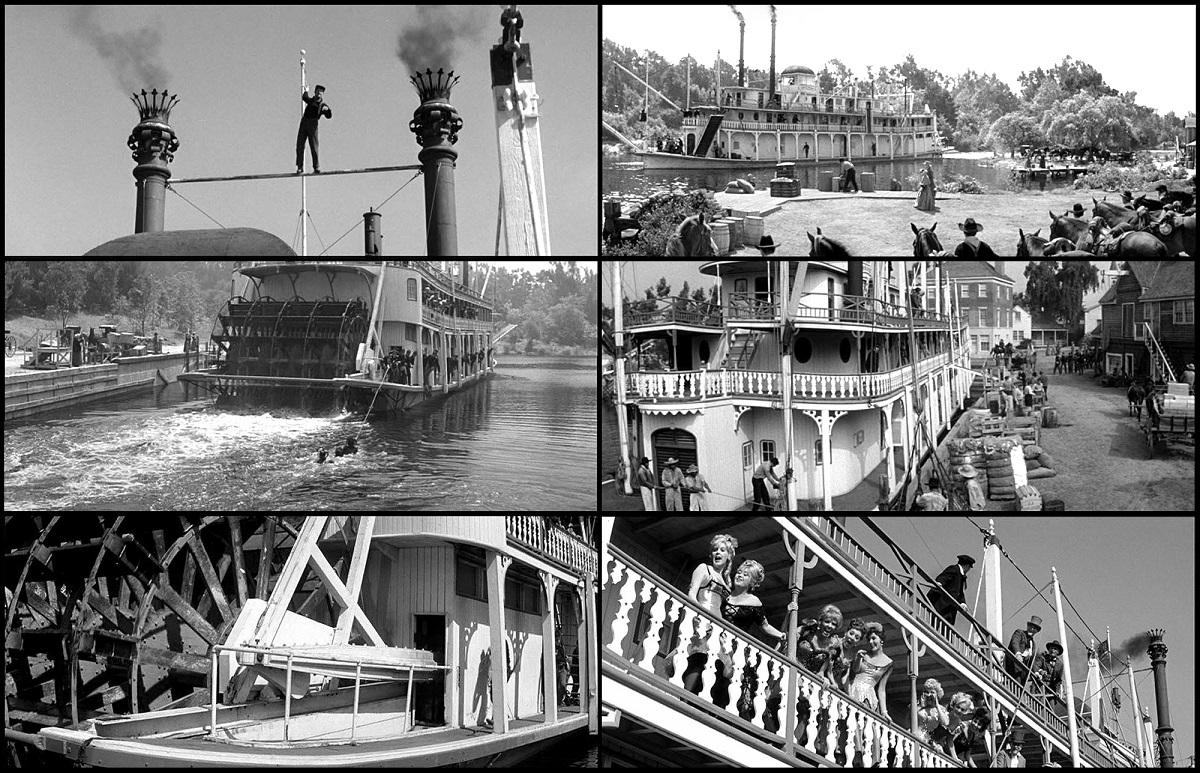

Above James Whale created a real "Show Boat" for his picture. Not seen in either the 1929 or 1951 movies, or any of the stage productions is the second boat in the still. In actuality the "Show Boat" was a floating theater with dressing rooms, but there was a second boat pushing it down the rivers. The second boat had the sleeping and eating quarters of the cast and crew and the power to move both boats.
The basic plot has "Magnolia" dreaming of finding the perfect man and along comes gambler "Gaylord" and the song "Make Believe". The two fall in love and are married, but "Gaylord" fears he can't provide for "Magnolia" and his daughter He leaves and the story follows what happens to both. "Magnolia" going on to be a major Broadway star and raising their daughter. "Gaylord" reverting to gambling and then realizing he must see his wife and daughter. He goes to one of "Magnolia's" shows and the two come together once more.

/_4by3/_derived_jpg_q90_600x800_m0/744-125.jpg?partner=allmovie_soap)
There are two major subplots in the story. One has to do with "Julie Laverne" and her husband "Steve Baker" portrayed by Donald Cook. He is standing next to Helen Morgan in the following still. Next to Cook is Helen Westley as "Magnolia's" mother "Parthenia 'Parthy' Hawks" and on the far right Charles Winninger as her father "Captain Andy Hawks".
/_16by9/_derived_jpg_q90_600x800_m0/744-66.jpg?partner=allmovie_soap)
_NRFPT_01.jpg)
At one stop on the river, "Sheriff Ike Vallon", Charles Middleton, shows up. He reveals that the White looking "Julie" is half-black. This forces "Julie" and "Steve" to leave their friends. Later the audience learns that "Steve" abandoned her and "Julie" has become an alcoholic and possibly more. In one scene Helen Morgan's "Torch Singing" brings the viewing audience to tears with her trade marked song "Bill".

The third story line, with comic stereo typed elements, is about "Joe" and his wife.

There is an excellent James Whale montage sequence as Paul Robeson sings his own trademarked "Ol' Man River". The original word "Nigger" was replaced by Whale and Robeson with "Darkies".


The motion picture was acclaimed at the time and a major box office hit for Universal Pictures, but in 1940 it was withdrawn from viewing and disappeared. This was because Metro-Goldwyn-Mayer had acquired the rights to the musical and planned to make their own version. Which didn't happen until 11 years later. Note the above poster has the word "1936 version" on it. In the 1960's the film was released for limited showings to Art Movie Houses. In my opinion, even though it was shot in black and white, Whale wanted to use Technicolor, it is far better than the later MGM film.
Song of Freedom released August 17, 1936
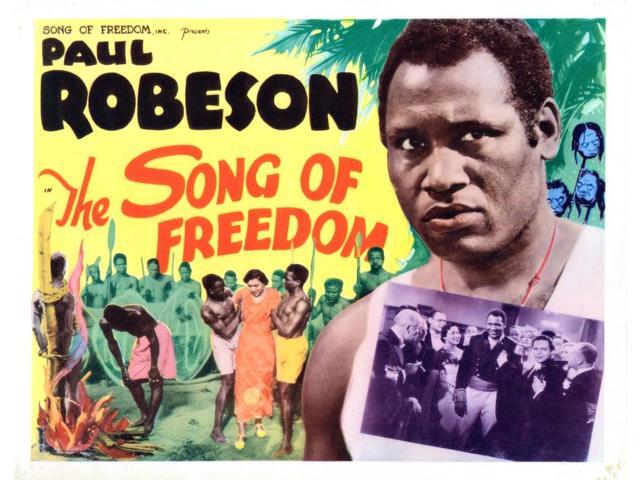
The screenplay for the British movie "Song of Freedom" was by playwrights Ingram D'Abbes and Fenn Hill Sherie. The picture was produced by Hammer Films. That would become known for its 1950's and 1960's Horror and Science Fiction motion pictures.
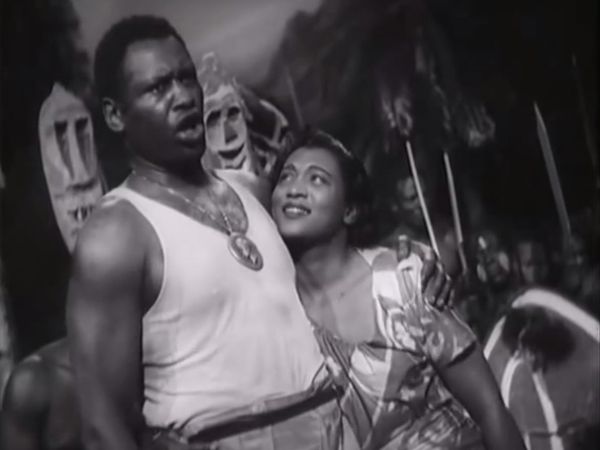
Above Paul Robeson as "John 'Johnny' Zinga". Described in the screenplay as "a black dockworker in England with a Great Baritone voice. With Robeson is Elisabeth Welch as "Ruth Zinga". Whose role is described as "John's wife who always encouraged 'John' whenever he was down".
Welch was a popular American "Torch Singer", entertainer and actress based in the U.K. She brought to England the sounds popular in the States. An example was the song "Stormy Weather" that had been first sang at the "Cotton Club" by songstress Ethel Waters and in the motion picture, of the song's name, by Lena Horne.
The film was directed with dignity by J. Elder Willis. Who would also direct Robeson's next feature film and as an art director for Hammer Films/ Willis would work on the classic motion picture version of the Science Fiction mini-series "The Quartermass X-Periment" in 1955.
The screenplay was based upon the novel "The Kingdom of Zinga" by Claude Wallace and Dorothy Holloway. It tells the history of "John Zinga's" family starting in 1700 . The audience follows the slave trade coming to the peaceful island of "Casanga" ruled over by "Queen Zinga". The screenplay next covers what happens to the family over the years. In 1838, 31 years after slavery has been banned in the British Empire, the chains are finally removed from members of the "Zinga" family and others. Then the story cuts forward to the story of "John".
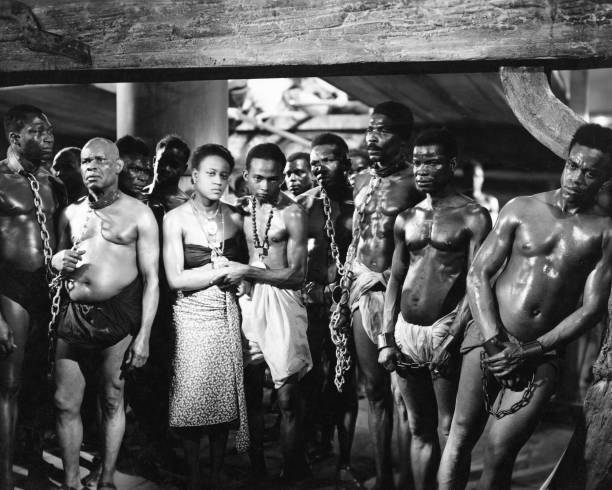
"John" has become a famous International Opera singer based in England, but learns he is the rightful King of the island of "Casanga". He takes "Ruth" and they go to the island.
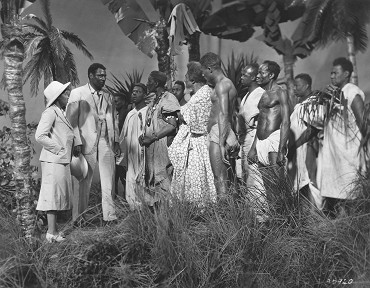
"John" has the Royal Medallion. Which he believed was only a family heirloom and had no idea what it meant. When "John", "Ruth" and his servant arrive on the island. The people they meet do not trust him. Even though the three are Black and not White like the old slavers.
"John" also learns he has an opponent who would block his claim to the throne. The year is 1936, but the island still uses a Witch Doctor/ Who doesn't really treat the sick, but locks them up and waits for the person to either get better, or die.. The story becomes a battle between old African ways and the modern world of "John" and "Ruth".
The Dockworker, turned Opera Singer, turned King, and his followers confront the Witch Doctor and his followers. The drums begin to play and "John" recognizes the music as the "Song of Freedom". The secret song passed on to each King of the island. He can't help himself and starts singing the song. The people realize "John Zinga" is their ruler. He leaves for America and returns with real medicine and medical care for his subjects.
Paul Robeson very much liked "Song of Freedom". He considered the picture an honest attempt to tell the African experience.
PART THREE:
1937 TO 1942 AND THE FBI
1937 was an interesting year in Paul Robeson's life.
The singer decided to make changes to his version of "Ol' Man River". The first change was to remove the word "Nigger" and replace it with "Darkies" as used in the 1936 motion picture. The original lyrics are:
For his version Robeson replaced the archaic wording of the song with modern English and finally changed one specific line from:
Ah gits weary/ An' sick of tryin'/ Ah'm tired of livin'/ An skeered of dyin'To become:
But I keep laffin'/ Instead of cryin'/ I must keep fightin'/ Until I'm dyinDuring 1937 there were three British made motion pictures and one short film.
My Song Goes Forth (Africa Sings, Africa Look Up) released at unknown date in 1937
This was a 33 minute documentary against South African apartheid. Paul Robeson sang the title song and added some commentary in a specially made prologue. The activist worked with director Joseph Best and rewrote the narration of the prologue. Here are his words:
Every foot of Africa is now parceled out among the white races. Why has this happened? What has prompted them go there? If you listen to men like Mussolini they will tell you it is to 'civilize' — a divine task, entrusted to the enlightened peoples to carry the torch of light and learning, and to benefit the African people... Africa was opened up by the white man for the benefit of himself — to obtain the wealth it contained.The lyrics of the song are:
From African jungle, kraal and hut
Where shadows fall on torrid light
My song goes forth and supplicates
In quest of love and right
I seek that star which far or near
Shows all mankind a pathway clear
To do unto his brother
And banish hate and fear
Big Fella released April 8, 1937
Paul was "Banjo" and Elisabeth Welch was back as "Amanda" aka: "Manda". The film had a cameo by Essie as the Cafe owner.
The plot is simple and somewhat familiar. Robeson is a dockworker in Marseilles, France. Welch is the cafe singer who loves him. The movie received much praise from the British press and especially for the singing of the two leads.

Then there was:
King Solomon's Mines released June 17, 1937

In 1885 British author H.Rider Haggard created the character of African guide and adventurer "Allan Quatermain" and a search for the legendary diamond mines of "King Solomon". This version from Gaumont British Picture Corporation is considered the best and most faithful to Haggard's work. Although if you, once again, believe American television. The MGM 1950 Technicolor version starring Deborah Kerr, Stewart Granger and Richard Carlson is the definitive version of the novel.
The production was shot in two locations.
The first was at Shepherds Bush Studio in London. At this location the director was Robert Stevenson. Among his work was the Boris Karloff 1936 feature "The Man Who Lived Again". Later, Stevenson would direct Orson Wells and Joan Fontaine in 1943's "Jane Eyre", but it is his work for Walt Disney that my generation remembers him. Those films were 1957's "Johnny Tremain" and "Old Yeller", 1958's "Zorro" television series, 1959's "Darby O'Gill and the Little People", 1960's "Kidnapped", 1961's "The Absent Minded Professor", 1962's "In Search of the Castaways", 1963's "Son of Flubber", 1964's "The Misadventures of Merlin Jones" and "Mary Poppins", 1965's The Monkey's Uncle" and "That Darn Cat", 1967's "The Gnome-Mobile", 1968's "Blackbeard's Ghost" and "The Love Bug", 1971's "Bednobs and Broomsticks", 1974's "Herbie Rides Again" and "The Island at the Top of the World", 1975's "One of Our Dinosaurs is Missing" and lastly 1976's "The Shaggy D.A.".
The second location was Africa and the eight week shoot was directed by Geoffrey Barkas. Barkas was actually a professional soldier from World War 1. Who lived in Africa and produced, wrote and directed some silent movies after that war. However, it was during the Second World War that he made his mark. With Barkas' background he was assigned too and led "The British Middle East Command Camouflage Directorate".
In short his group designed means of deceiving Rommel and executed "Operation Bertram". Which was literally a film set that convinced the German's into believing General Bernard Law Montgomery was preparing for an major operation is a different area of North Africa. Then the real location of the Allied Invasion site.
The cast of "King Solomon's Mines" was excellent:
Cedrick Hardwicke was "Alan Quartermain". Note the slight change in the spelling.
This was Hardwicke's last British film prior to World War 2. His next picture was in the United States and was MGM's 1939 "On Borrowed Time". Which would be followed by the same years "Stanley and Livingston" starring Spencer Tracy. Also in 1939 was RKO's "The Hunchback of Notre Dame" introducing Maureen O'Hara, starring Charles Laughton and co-starring the now SIR Cedrick Hardwicke.
Paul Robeson was "Umbopa".
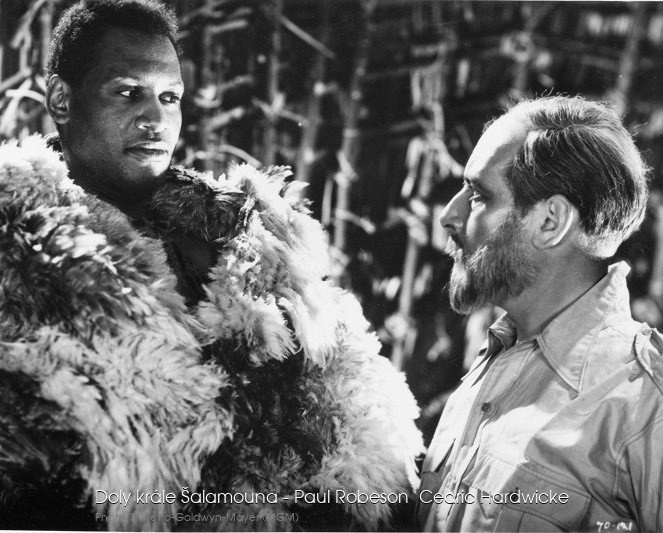
Anna Lee was "Kathy O'Brien". Like other British actors Lee moved to the United States at the start of World War 2. Among the films Americans saw Anna Lee included two from director John Ford. They were his 1941 "How Green Was My Valley" and 1948's "Fort Apache". Anna Lee's first American film was a comedy opposite another British actor Ronald Coleman in 1941's "My Life With Caroline". Lee was Boris Karloff's co-star in 1936's "The Man Who Lived Again" and the victim of Val Lewton's 1946 "Bedlam" with Karloff.,
John Loder was "Sir Henry Curtis". Loder appeared with Anna Lee and Boris Karloff in 1936's "The Man Who Lived Again" and the same year starred in Alfred Hitchcock's "Sabotage". Loder was also with Lee in 1937's "Non-Stop New York" and John Ford's 1941 "How Green Was My Valley". In the United States Loder became a tall, debonair "B" leading man sporting his British accent.
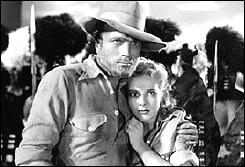
Roland Young was "Commander John Good".Young was "Dr. Watson" to John Barryumore's "Sherlock Holmes" in 1922. In 1936 he was H.G. Wells' "The Man Who Worked Miracles" and in 1937 co-starred with Cary Grant and Constance Bennett in the first of a successful motion picture series as "Topper". In 1945 Roland Young was one of the victims in the best version of Agatha Christie's "And Then There Was None".
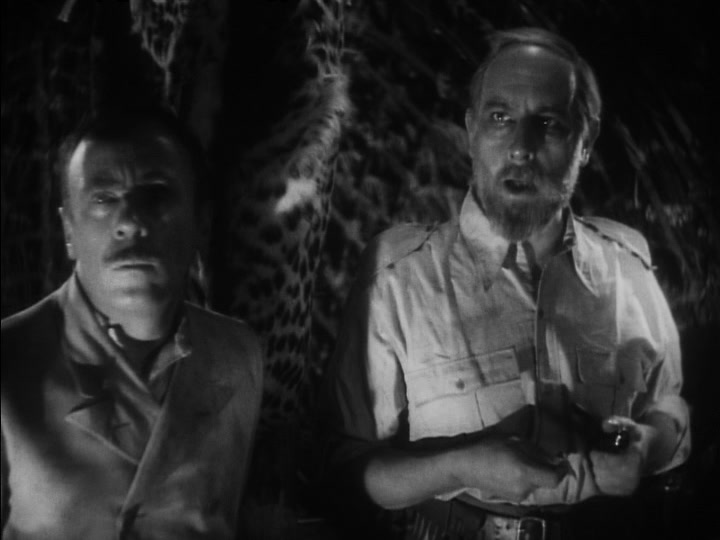
Above Roland Young is on the left with Cedric Hardwicke.
The year is 1882, "Patrick 'Patsy' O'Brien", Arthur Sinclair, and his daughter "Kathy" have failed to strike it rich in the Kimberley diamond fields. The two persuade a reluctant "Alan Quartermain" to give them a lift in his ox cart to the coast. They plan to go back to Ireland.
The three come across another wagon with two men who are dying. One is the native "Umbopa" and the other "Silvestra Getto", Arthur Goulet, who does dies, but not before bragging about "King Solomon's" diamond mines and showing the others a map. During the night "Patsy" steals the map and disappears.
"Kathy" cannot convince "Quartermain" to go after her father. Instead she meets the big game hunters new clients "Sir Henry Curtis" and retired Navy "Commander Good". "Kathy" steals "Allan Quartermain's" wagon forcing him, accompanied by "Curtis", "Good" and "Umbopa", to go after her. Once they find the girl the obvious love story between "Kathy" and "Henry" begins and the group goes after her father.


This all will lead to discovering a tribe of natives guarding the diamond mines. A female witch doctor named "Gagool", Sydney Fairbrother, and an evil King named "Twala" played by Robert Adams. Before this happens the group meets with some warrior tribesmen and "Umbopa" speaks to them alone.

For some reason part of the native group goes one way and the others escort "Quartermain's" party to the main Kraal.
That night "Umbopa" reveals he is the rightful King, but needs a trick to counter the magic that "Gagool" will use to have them all killed. "Good" consults an almanac he has been carrying and discovers that at 11:15 AM the following day a total eclipse of the sun will take place.
As "Gagool" orders the execution of some of the tribesman who are against "Twala". "Umbopa" reveals himself to the tribe, uses the eclipse to prove who he is and a rebellion, caused by those natives who left the group originally, breaks out.

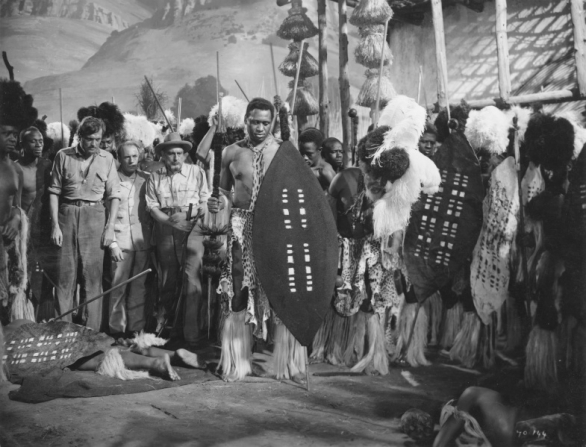
In the end "Curtis" shoots "Twala" and "Umbopa" is recognized as King. "Gagool" leads the others to the mines and seals them inside. "Kathy" finds her father alive, but with a broken leg.
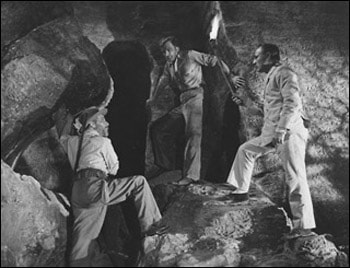
"Gagool" is killed in a cave in and the others are rescued. Leaving "King Umbopa" to rule his people in peace.
During the trek to find "Kathy's" father Paul Robeson does have a couple of songs.
Jericho released August 23, 1937
This British production would be released one year later in the United States as "Dark Sands" on
August 16, 1938.
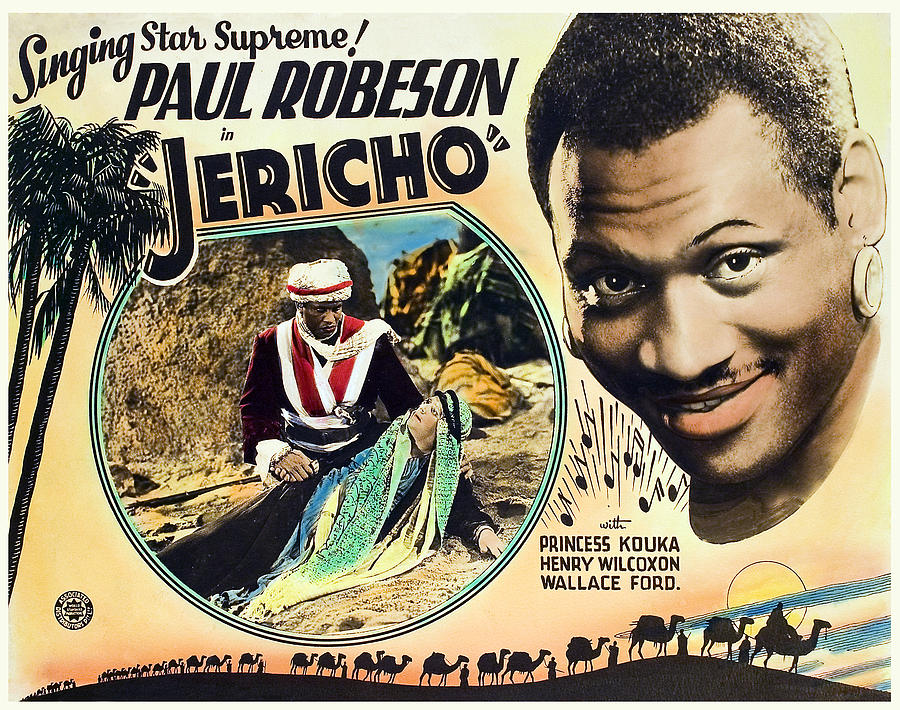
Note the difference between the above U.K. poster and the United States poster below. It would seem to be two different motion pictures.

During World War One an American troop ship is torpedoed and many soldiers and sailors are trapped below decks.
Paul Robeson portrayed "Corporeal Jericho Jackson" a medical student drafted into the war.
After the torpedoing he saves many men through his medical training, but accidentally kills his squads officer. This came about during an argument, because "Jericho" refused to abandon ship as the officer ordered to treat the men. Despite his heroism and saving so many lives. "Jericho" is brought before a court-martial for refusing a direct order and sentenced to jail. "Jericho"s" commanding officer, "Captain Mack", is held responsible and also brought before a court-martial.
"Captain Mack" was portrayed by Henry Wilcoxon. Wilcoxon was a favorite of Cecil B. DeMille. He was "Anthony" in 1934's "Cleopatra" starring Claudette Colbert, "Richard the Lion Hearted" in DeMille's 1935 "The Crusades", was in the directors 1947, "Unconquered", 1949's "Samson and Delilah" and 1956's "The Ten Commandments".
"Jericho" ends up in North Africa and meets the Tuareg people. There his medical skill impress them and they accepted him into the tribe. He marries and starts to raise a family.
The real actress, Princess Kouka, portrayed his wife "Gara". Kouka was a Sudanese actress Very little is known about her other than she was apparently Sudanese royalty.
Eventually "Jericho" becomes the tribes leader, fights other tribes and brings peace to the region. However, "Captain Mack" is in London movie audience when he sees newsreel footage and recognizes the man responsible for his court-martial. He flies to confront the ex-corporeal, but seeing what good he has done. Changes his mind and the film ends with him flying away.
The original ending was written with "Jericho" agreeing to go to the United States to help clear "Mack's" name. Their plane crashes in the desert and "Jericho" dies, but Robeson didn't want this ending and it was changed.
Between 1936 and 1939 the "Spanish Civil War" took place. There were two sides the "Republicans" and the "Nationalists". The make-up of these two groups might belay the titles.
The "Republicans" were loyal to the left leaning current government "The Second Spanish Republic".The make up of those fighting on that side were the "Anarchists" and the "Spanish Communists".
While the "Nationalists" were being supported by the "Monarchists" and "Catholics". Along with the"Carlists" who wanted to take the Spanish throne for the Bourbons, and the "Falangism" the fascist supporters of General Franco.
In 1937 Paul Robeson truly became an activist and his concerts were for the support of the "Republicans" in the "Spanish American War". At the same time there was an American writer covering the war for the "North American Newspaper Alliance" and, also, supporting the "Republican Cause". His name was Ernest Hemingway and in 1940 his novel, based upon his experiences, "For Whom the Bell Tolls" would be published.
In 1938 Paul Robeson's business agent became very concerned about his activism. Robeson had been invited to Spain and he visited hospitals for those of the "International Brigade". The Brigade was fighting for the "Republican Cause" and were mainly members of the Communist Party.
On July 7, 1937 the "Second Sino-Japanese War" broke out. Robeson supported the Chinese. On September 1, 1939 Hitler invaded Poland and the Second World War began. The "Second Sin-Japanese War" would not be settled until World War 2 had ended.
In 1940 Chinese progressive activist Liu Liangmo taught Paul Robeson the Chinese patriotic song "Chee Lail (Arisel)". He learned the words in Chinese and at his next British concert Paul began to sing it.
On tour in the United States Paul Robeson gave a sold out benefit concert for the "China Aide Council" and the "United China Relief" in Washington, D.C. It was held at the Uline Arena (Washington Coliseum) on April 24, 1941 and he sang "Chee Lail". This was to have been followed by a second concert sponsored and booked by "The Washington Committee for Aide to China", but the concert was blocked by the "Daughters of the American Revolution" because of Paul Robeson's race. Overlooking how many African-Americans fought and died during the actual American revolution. Eleanor Roosevelt and Chinese Ambassador Hu Shih,became sponsors of Robeson's concert as a result of the DAR. They offered reduced price tickets to the "National Negro Congress:, but other sponsors withdrew support because of the "NNC's" pro-communist views.
In 1968 Liu Liangmo died in a Communist prison cell in Beijin, but his song sung by Robeson was so popular. That Paul kept sending royalties to Liu's family until the end of his own life.
.
Returning to 1940 in the U.K.was:
The Proud Valley released April 6, 1940
On the posters for this his last British film. Paul Robeson was billed as:

Instead of a Black dock worker. In this film set in Wales, Paul Robeson, was American Black coal miner "David Goliath".
The motion pick was a critical look at the lives and problems facing Welch coal miners. "David's" work ethic and singing gain the respect of the White miners and he joins a local choir.


With the war building throughout Europe. Paul Robeson moved his family back to the neutral United States and set up home in Enfield, Connecticut. On radio he started singing a very patriotic song "The Ballard for Americans", originally called "The Ballad for Uncle Sam", and an article in "Collier's Magazine" called Robeson America's:
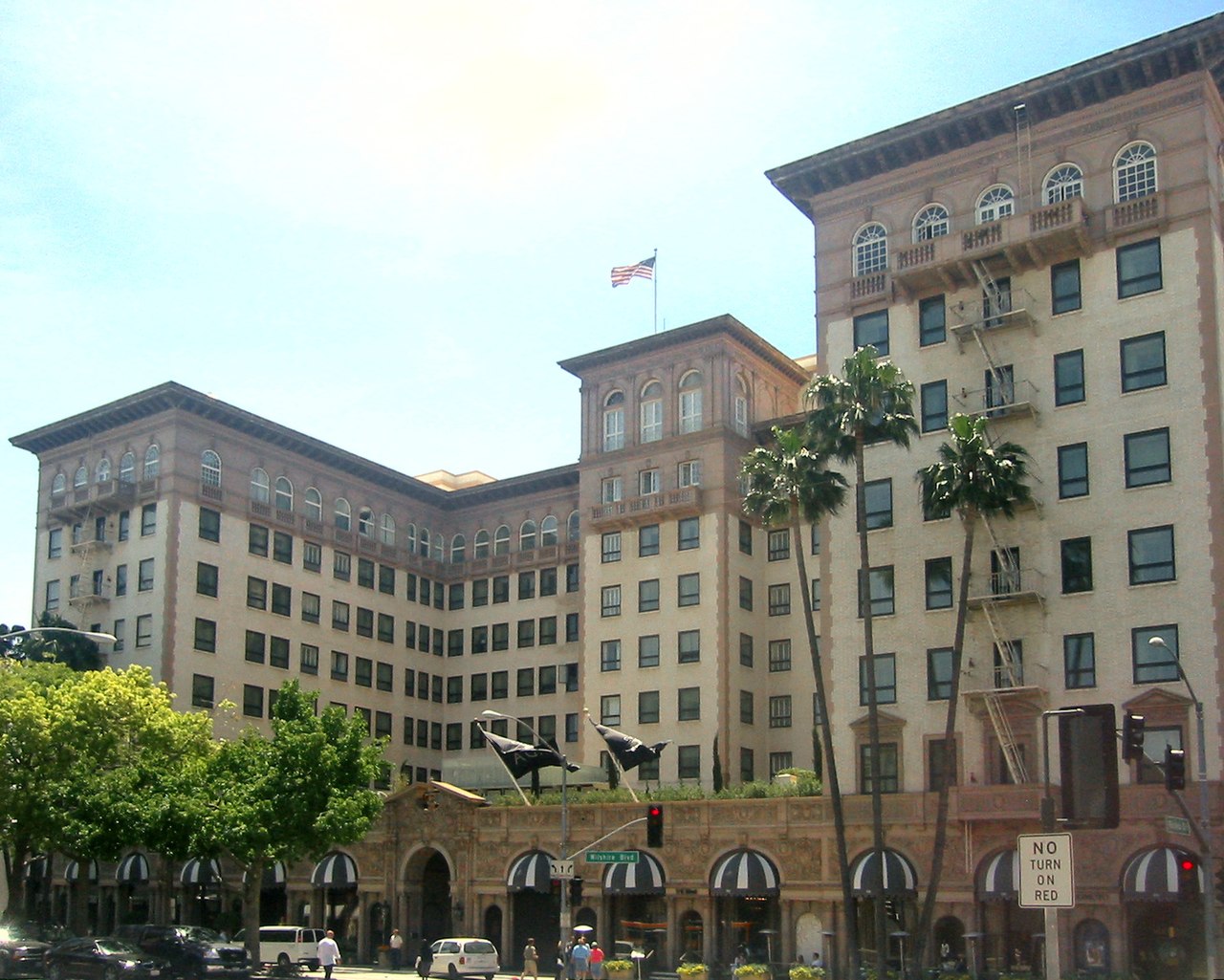
Their stipulation was that Paul Robeson register for his room under an assumed name. He would set in the hotel lobby and when asked. He explained what he doing, according to composer Earl Robinson, who wrote the music for "The Ballad for Uncle Sam", that his action was:

Paul Robeson was the narrator and vocalist for this documentary style motion picture. The film was made up of actual footage and reenactments. It dealt with the struggle of American Trade Unions against Union Busting corporations.
However, the Federal Bureau of Investigation (FBI) and J. Edgar Hoover labeled the film "COMMUNIST PROPAGANDA" and they were now, if not before, watching Paul Robeson.
The picture was based upon the findings of the U.S. Senate "La Follette Committee Report", or as its full name went "Committee on Education and Labor, Subcommittee Investigating Violations of Free Speech and the Rights of Labor" formed in 1936 and ended in 1941. No question the group the movie was based upon was a Communist Front Group.
Tales of Manhattan released August 5, 1942
The screenplay by 13 writers was based upon the Mexican novel "Historia de un frac( Story of a Tailcoat)" and follows a black formal tailcoat through unrelated stories about unrelated owners of the coat.

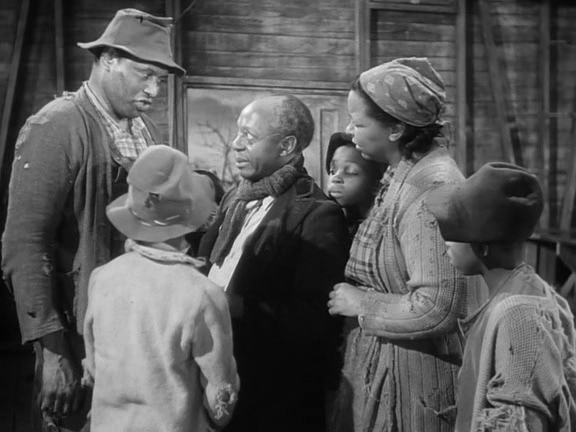
The above is a scene from the last story. In the proceeding tale a crook had the coat on to get into an upscale gambling joint and rob it. While escaping on a plane the jacket catches fire. The panicked crook throws it out the door in flight with $43,000 in it. The jacket and the money land beside a poor crop farmer "Luke" played by Paul Robeson. Along with his wife "Esther", Ethel Waters, they take it to their minister played by Eddie Anderson. The couple has decided to give it to their congregation to permit everyone to get something they have prayed for.
After what he considered a demeaning role about "his people" Paul Roberson never appeared in another motion picture.
PART FOUR:
OTHELLO AND BEING CALLED BEFORE CONGRESS
In 1943 with Uta Hagen as "Desdemona". Paul Robeson became the first Black actor to portray "Othello" on the Broadway Stage with an all White supporting cast. Hagen was the wife of actor Jose Ferrer who portrayed "Iago". The company would take the production on the road afterwards.


The tour would last into 1945. Then on July 26, 1946 what was known as the "Moore Ford Lynchings" took place in Georgia on the "Moore Ford Bridge".




In truth there were no lynchings as tradition holds. What actually happened was that two young Negro married couples were shotgunned to death. They were George W. and Mae Murray Dorsey and Roger and Dorothy Malcolm.
Paul Robeson met with President Harry Truman and demanded that he pass anti-lynching legislation OR, according to biographer Martin B. Duberman:
Two events did occur after this meeting.
The first event saw Paul Robeson form "The American Crusade Against Lynching" to wake up Americans to what was happening in the South. Robeson's group was founded on September 23, 1946 the anniversary of the "Emancipation Proclamation". However, the "National Association for the Advancement of Colored People (NAACP)" considered Robeson organization as trouble for their own anti-violence movement and put political and local pressure to stop him.
The second event was the result of wide spread public opinion and pressure. President Truman created the "Presidents Committee on Civil Rights" and introduced anti-lynching legislation in Congress. The bill was blocked by the powerful "Southern Democrat Block".
71 years later on September 2017 the FBI and the State of Georgia finally closed their investigations into the "Moore's Ford Lynching". Stating both were unable to find anyone responsible.
It was about the time of the "Moore Ford Lynchings". That Paul Robeson decided trade unions were a mainstay part of civil rights. So that idea was incorporated into his own beliefs and became a follower of Revels Cayton. Cayton was a Civil Rights Leader in Washington State and California. Revels was the grandson of the First Black Senator in the United States Congress Hiram Rhodes Revels. Who was both a Republican and represented the State of Mississippi in 1870.
The one downside for Paul Robeson to be associated with Revels. Was that Clayton was a known Communist Party Member.
Between 1941 and 1949 Jack Tenney was first a DEMOCRAT Representative in the California State Assembly. Then, because he wouldn't have been elected as a Democrat. Tenney became a REPUBLICAN and served in the California State Senate.
In the California Senate, after the Second War was over, Tenney became the Chairman of the "California Senate Fact Finding Subcommittee on Un-American Activities". In short a mini-Joseph McCarthy.
One of those he zeroed in on was actor Edward G. Robinson. State Senator Tenney denounced Robinson as frequently being involved with Communist fronts and causes. Robinson had done what became a cardinal sin for the motion picture industry during the McCarthy Era.
Even if you denounced Hitler, the Nazi's, Mussolini's fascism and the Japanese during the war. However, you did not denounce Stalin, our ally at the time, you were considered a Communist sympathizer after the war. Hence, California Senator Tenney's attacks/
Then there was Paul Robeson and guilt by association with Revels Cayton took place. Was he a member of the "Communist Party USA (CPUSA)"?
Answer, "NO!".
"CPUSA" was established in 1919 after a split with the "Socialist Party of America". Starting in the 1920's the "Communist Party USA" was known for defending and fighting for labor unions and opposing racism and racial segregation. The group provided funds for the defense of the "Scottsboro Boys". They were nine African-American boys, between 13 and 20, falsely accused in Alabama of raping two white women in 1931. Below the boys with their attorney.
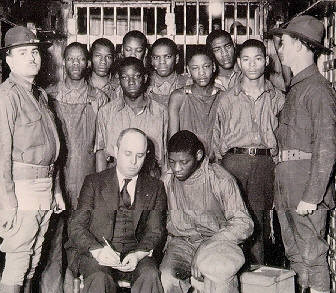
During the "Great Depression" membership in "CPUSA" increased as Americans looked for work and fair wages. The "Communist Party USA" played a key role in the creation of John L. Lewis' "Congress of Industrial Organization (CIO)".
In short this was not "Stalin's" Communist Party. The organizations membership declined at the end of World War 2. During the start of what was called the "Second Red Scare" and the raise of Senator Joseph McCarthy.
However, another organization Paul Robeson was a member provided problems for the singer and actor. This was the "Civil Rights Congress (CRC)". "The "CRC" was established in 1946 and was disbanded ten years later. in 1956. They created the "International Labor Defense". Which was an American communist backed organization to provide lawyers to defend Americans in the labor movement. Along with the "National Federation for Constitutional Liberties (NFCL)". A organization made up of trade union, religious groups, African-American civil rights groups and the ":National Negro Congress". The last being a group formed at Howard University to fight for Negro rights.
There was a second organization the "CAA", but I could not find out what it was about.
Both the "CRC" and "CAA" were placed on the United States "Attorney General's List of Subversive Organizations". The list was originally created by FDR's "Attorney General", Francis Biddle, and was known also as "The Biddle List".
As a result Paul Robeson was called before the "United States Senate Committee on the Judiciary". Where Robeson was asked about his affiliation with the Communist Party. He refused to answer the committee's questions and according to the Bay Area Paul Roberson Centennial Committee, PO Box 3628, Oakland, CA, he replied:
PART FIVE:
BLACKLISTED AND THE HOUSE COMMITTEE ON UN-AMERICAN ACTIVITIES
Three events occurred for Paul Robeson in 1948. Henry A. Wallace ran for President of the United States. Wallace had been the 11th United States Secretary of Agriculture, the 33rd United States Vice President under FDR and the 10th United States Secretary of Commerce and was now the Presidential Candidate of the Left-Wing "Progressive Party".
The "Progressive Party's 1948 Platform" sought desegregation, the establishment of a national health insurance program and the nationalization of the energy industry. The problem was they also supported renewing friendly relations with the Soviet Union.
Paul Robeson supported Wallace for President and went into the "Deep South", at risk to his life, to campaign for the ex-Vice President. Who was dropped by FDR for Harry Truman.
The second event occurred while touring Europe. Paul Robeson spoke at the "World Peace Council" founded in 1948. The "WPC" was under the direction of the "International Department of the Central Committee of the Soviet Communist Party". Although Robeson claimed otherwise. His speech was reported to have equated the United States to a Fascist State.
The third event took place back in July of 1948 with the arrest of 12 leaders of the "CPUSA". Paul Robeson refused to bow to public criticism and supported the defendants in what would became known as the "Smith Acts Trials of Communist Party Leaders".
Part of Robeson's reason for supporting these men was that one, Benjamin J. Davis, Jr., was a personal friend for decades. The actual trials took place in New York City between 1949 and 1958. Each of the 12 members of "CPUSA" were charged with violating the "Smith Act".
"The Smith Act" was actually the "Alien Registration Act". It had first been introduced by Representative Howard W. Smith, of Virginia, in 1939. The act set criminal penalties for advocating the overthrowing of the American Government by force, or violence. It also required the registration of all adult non-citizens with the United States Government.
Benjamin J. Davis, Jr. was a lawyer, a strong civil rights activist and openly a communist all his adult life. He was elected to the New York City Council representing Harlem in 1943. It wasn't until After World War 2 ended that Davis suddenly faced growing opposition outside of Harlem. It was during his third term on the city council that he was expelled. This happened after being convicted under the "Smith Act". Benjamin J. Davis, Jr., would serve three years and four months in Federal Prison. Below Davis leaving the court house during his trial surrounded by supporters/

While the actual trials of the "Smith Act Defendants" started. Paul Robeson was forced to go to Europe to find work, because all his American concerts were being blocked by the FBI. For no other reason than J. Edgar Hoover viewed Paul Robeson as a card carrying Communist.
On June 20, 1949 Robeson addressed the "Paris Peace Congress". Paul, Jr. in his biography of his father states that part of that address was:
The "Blacklisting" was followed by the "HUAC's" next move to completely isolate Paul Robeson and clearly tag him a communist sympathizer. The committee subpoena Baseball Player Jackie Robinson, o testify against Paul Robeson.
Robinson said of Robeson statements:
Days later Paul Robeson was to headline a concert in New York City. The local newspapers claimed the concert was supporting "subversives" such as Robeson. The local Press did their duty to country too well and the result was called the "Peekskill Riots". The riots consisted of anti-Communist demonstrators, anti-Black demonstrators and anti-Semitic demonstrators converging on those in support of Paul Robeson and themselves.

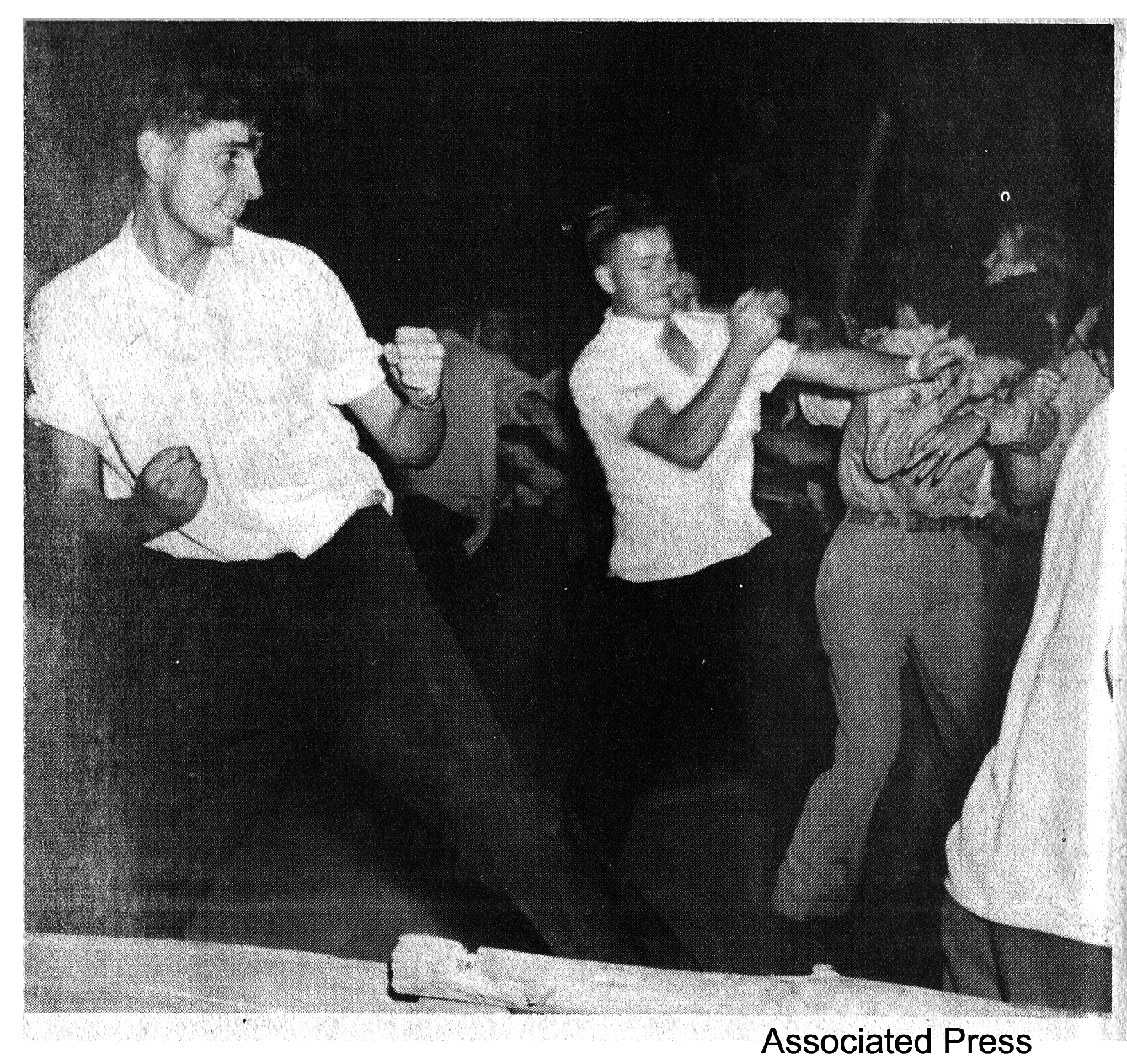

PART SIX:
AFTERMATH OF BEING BLACKLISTED
A book calling itself the "most complete record of college football" was published. When it came to Rutgers College there was no mention of All-American Paul Robeson, or that he ever played football there.
The State Department revoked Paul Robeson's passport stating that by isolating his travel he would not be a threat to the United States.
According to Martin B. Duberman's previously mentioned work. When Robeson asked State Department Officials why his passport was revoked. They replied that:

In 1951` an article in "The Crisis" against Paul Robeson was published. J. Edgar Hoover ordered it copied and distributed in African Countries to damage Robeson's reputation and reduce communist influence with colonial countries looking for self rule.
On December 17, 1951 Paul Robeson presented to the United Nations his anti-lynching pamphlet "We Charge Genocide". This accused the United States of Genocide under the guidelines set by the "Convention on the Prevention and Punishment of the Crime of Genocide" adopted by the U.N. on December 9, 1948.
In 1952 Paul Robeson was awarded the "International Stalin Prize", originally called the "International Prize for Strengthening Peace Among Peoples", by the Soviet Union. As his passport was revoked he went to New York City to accept it at the Soviet Embassy.
In May 1952 as a symbolic act of defiance against the United States State Departments ban of travel out of the country for Paul Robeson. Labor Unions in both the United States and Canada came together to organize a concert on the border between Washington State and British Columbia. The concert was held at the "Peace Arch"
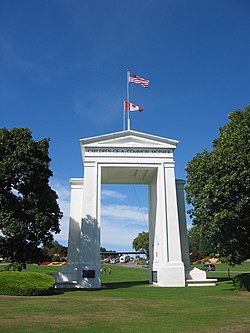
In 1953 Robeson returned for a second concert. In 1954 there was an East German documentary filmed and released entitled "Das Lied der Strome (Song of the Streams)". It was released in English speaking countries as Song of the Rivers". Paul Robeson wasn't seen in this film about international workers movements along the Volga, Ganges, Nile, Amazon, Yangtze and Mississippi. However, his singing and narrating voice was heard.
In May 29, 1956 Paul Robeson was called before the "House Committee on Un-American Activities".

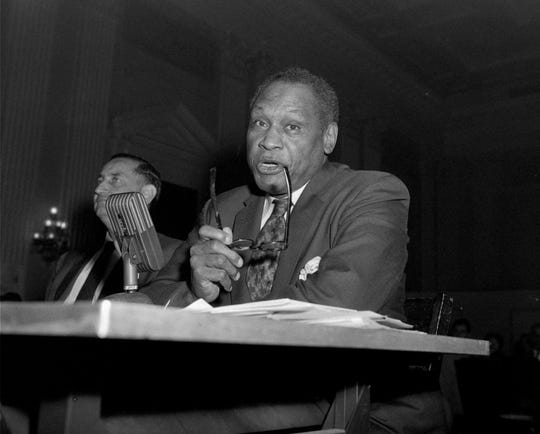
On June 12, 1956 the following testimony was given as reported by the website "History Matters":
http://historymatters.gmu.edu/d/6440/
In 1958 the United States Supreme Court ruled that a citizens right to travel abroad COULD NOT be taken away. Paul Robeson's passport was reinstated.
On his March 9, 1954 radio broadcast Edward R. Morrow told America:
In 1956 the British record label "Topic Records" released a recording by Paul Robeson. On it he sings two songs. One was "Joe Hill" a folk song about the Labor Union activist. The second song was a version of "John Brown's Body" about the abolitionist. As of this writing this record is still the number one favorite, apparently, with politicians of the British Labor Party,

Above Side One of the record and below the back cover of another "Topic Records" release.

With his passport restored Paul Robeson started a worldwide concert tour. On October 11, 1959 the singer became the first African-American to sing within London's "St. Paul's Cathedral". Robeson was going to perform in India, but prior to the performance. The United States State Department released anti-Robeson flyers in several Indian languages.
1959 British audiences saw Paul Robeson, on stage once more, in William Shakespeare's "Othello" produced by Tony Richardson.
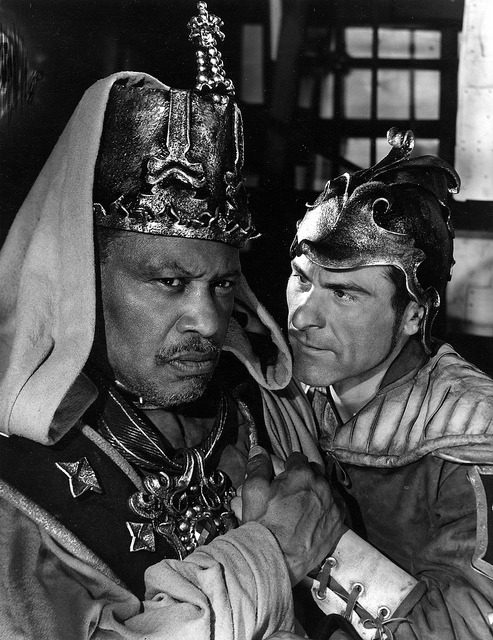
Returning to Paul Robeson, Jr's biography of his father. His father decided to return to the United States over Essie's objections and concerns for his safety. On the way Paul stopped in Moscow during March 1961. After what was described as an uncharacteristically wild party for the singer. He developed paranoia and in a hotel room attempted suicide by cutting his wrists. Moscow doctors saved him and Paul, Jr, for the rest of his own life, believed his father had been drugged by the "Central Intelligence Agency (CIA)", or the British "MI-5" to "neutralize him".
While Martin B. Dubmann believes Paul Robeson's health problems were brought up by extreme stress, the beginning of circulatory and heart problems and, at the time, misdiagnosed bi-polar depression.
In 1965 Paul Robinson returned to the United States and went into seclusion for the rest of his life. On December 13, 1965 Eslanda "Essie" Cardozo Goode Robinson passed away in New York City.
On January 23, 1976 Paul Robeson passed away in Philadelphia, Pennsylvania.

Paul Robeson portrayed "Corporeal Jericho Jackson" a medical student drafted into the war.
After the torpedoing he saves many men through his medical training, but accidentally kills his squads officer. This came about during an argument, because "Jericho" refused to abandon ship as the officer ordered to treat the men. Despite his heroism and saving so many lives. "Jericho" is brought before a court-martial for refusing a direct order and sentenced to jail. "Jericho"s" commanding officer, "Captain Mack", is held responsible and also brought before a court-martial.
"Captain Mack" was portrayed by Henry Wilcoxon. Wilcoxon was a favorite of Cecil B. DeMille. He was "Anthony" in 1934's "Cleopatra" starring Claudette Colbert, "Richard the Lion Hearted" in DeMille's 1935 "The Crusades", was in the directors 1947, "Unconquered", 1949's "Samson and Delilah" and 1956's "The Ten Commandments".
"Jericho" ends up in North Africa and meets the Tuareg people. There his medical skill impress them and they accepted him into the tribe. He marries and starts to raise a family.
The real actress, Princess Kouka, portrayed his wife "Gara". Kouka was a Sudanese actress Very little is known about her other than she was apparently Sudanese royalty.
Eventually "Jericho" becomes the tribes leader, fights other tribes and brings peace to the region. However, "Captain Mack" is in London movie audience when he sees newsreel footage and recognizes the man responsible for his court-martial. He flies to confront the ex-corporeal, but seeing what good he has done. Changes his mind and the film ends with him flying away.
The original ending was written with "Jericho" agreeing to go to the United States to help clear "Mack's" name. Their plane crashes in the desert and "Jericho" dies, but Robeson didn't want this ending and it was changed.
Between 1936 and 1939 the "Spanish Civil War" took place. There were two sides the "Republicans" and the "Nationalists". The make-up of these two groups might belay the titles.
The "Republicans" were loyal to the left leaning current government "The Second Spanish Republic".The make up of those fighting on that side were the "Anarchists" and the "Spanish Communists".
While the "Nationalists" were being supported by the "Monarchists" and "Catholics". Along with the"Carlists" who wanted to take the Spanish throne for the Bourbons, and the "Falangism" the fascist supporters of General Franco.
In 1937 Paul Robeson truly became an activist and his concerts were for the support of the "Republicans" in the "Spanish American War". At the same time there was an American writer covering the war for the "North American Newspaper Alliance" and, also, supporting the "Republican Cause". His name was Ernest Hemingway and in 1940 his novel, based upon his experiences, "For Whom the Bell Tolls" would be published.
In 1938 Paul Robeson's business agent became very concerned about his activism. Robeson had been invited to Spain and he visited hospitals for those of the "International Brigade". The Brigade was fighting for the "Republican Cause" and were mainly members of the Communist Party.
On July 7, 1937 the "Second Sino-Japanese War" broke out. Robeson supported the Chinese. On September 1, 1939 Hitler invaded Poland and the Second World War began. The "Second Sin-Japanese War" would not be settled until World War 2 had ended.
In 1940 Chinese progressive activist Liu Liangmo taught Paul Robeson the Chinese patriotic song "Chee Lail (Arisel)". He learned the words in Chinese and at his next British concert Paul began to sing it.
On tour in the United States Paul Robeson gave a sold out benefit concert for the "China Aide Council" and the "United China Relief" in Washington, D.C. It was held at the Uline Arena (Washington Coliseum) on April 24, 1941 and he sang "Chee Lail". This was to have been followed by a second concert sponsored and booked by "The Washington Committee for Aide to China", but the concert was blocked by the "Daughters of the American Revolution" because of Paul Robeson's race. Overlooking how many African-Americans fought and died during the actual American revolution. Eleanor Roosevelt and Chinese Ambassador Hu Shih,became sponsors of Robeson's concert as a result of the DAR. They offered reduced price tickets to the "National Negro Congress:, but other sponsors withdrew support because of the "NNC's" pro-communist views.
In 1968 Liu Liangmo died in a Communist prison cell in Beijin, but his song sung by Robeson was so popular. That Paul kept sending royalties to Liu's family until the end of his own life.
.
Returning to 1940 in the U.K.was:
The Proud Valley released April 6, 1940
On the posters for this his last British film. Paul Robeson was billed as:
The Samson of Song

Instead of a Black dock worker. In this film set in Wales, Paul Robeson, was American Black coal miner "David Goliath".
The motion pick was a critical look at the lives and problems facing Welch coal miners. "David's" work ethic and singing gain the respect of the White miners and he joins a local choir.


With the war building throughout Europe. Paul Robeson moved his family back to the neutral United States and set up home in Enfield, Connecticut. On radio he started singing a very patriotic song "The Ballard for Americans", originally called "The Ballad for Uncle Sam", and an article in "Collier's Magazine" called Robeson America's:
Number One Entertainer.He may have been, but on touring the United States. Finding a place to stay for "America's Number One Entertainer" was another matter. He was Black and most "Decent Hotels" were racist and would not permit him to stay there. However, in the Los Angeles area, the "The Beverly Wilshire Hotel", at 9500 Wilshire Boulvard, Beverly Hills, thought otherwise with one stipulation.

Their stipulation was that Paul Robeson register for his room under an assumed name. He would set in the hotel lobby and when asked. He explained what he doing, according to composer Earl Robinson, who wrote the music for "The Ballad for Uncle Sam", that his action was:
to ensure that the next time Black[s] come through, they'll have a place to stayThe Native Land released May 11, 1942

Paul Robeson was the narrator and vocalist for this documentary style motion picture. The film was made up of actual footage and reenactments. It dealt with the struggle of American Trade Unions against Union Busting corporations.
However, the Federal Bureau of Investigation (FBI) and J. Edgar Hoover labeled the film "COMMUNIST PROPAGANDA" and they were now, if not before, watching Paul Robeson.
The picture was based upon the findings of the U.S. Senate "La Follette Committee Report", or as its full name went "Committee on Education and Labor, Subcommittee Investigating Violations of Free Speech and the Rights of Labor" formed in 1936 and ended in 1941. No question the group the movie was based upon was a Communist Front Group.
Tales of Manhattan released August 5, 1942
The screenplay by 13 writers was based upon the Mexican novel "Historia de un frac( Story of a Tailcoat)" and follows a black formal tailcoat through unrelated stories about unrelated owners of the coat.


The above is a scene from the last story. In the proceeding tale a crook had the coat on to get into an upscale gambling joint and rob it. While escaping on a plane the jacket catches fire. The panicked crook throws it out the door in flight with $43,000 in it. The jacket and the money land beside a poor crop farmer "Luke" played by Paul Robeson. Along with his wife "Esther", Ethel Waters, they take it to their minister played by Eddie Anderson. The couple has decided to give it to their congregation to permit everyone to get something they have prayed for.
After what he considered a demeaning role about "his people" Paul Roberson never appeared in another motion picture.
PART FOUR:
OTHELLO AND BEING CALLED BEFORE CONGRESS
In 1943 with Uta Hagen as "Desdemona". Paul Robeson became the first Black actor to portray "Othello" on the Broadway Stage with an all White supporting cast. Hagen was the wife of actor Jose Ferrer who portrayed "Iago". The company would take the production on the road afterwards.


The tour would last into 1945. Then on July 26, 1946 what was known as the "Moore Ford Lynchings" took place in Georgia on the "Moore Ford Bridge".




In truth there were no lynchings as tradition holds. What actually happened was that two young Negro married couples were shotgunned to death. They were George W. and Mae Murray Dorsey and Roger and Dorothy Malcolm.
Paul Robeson met with President Harry Truman and demanded that he pass anti-lynching legislation OR, according to biographer Martin B. Duberman:
the Negroes will defend themselvesPresident Truman stopped the meeting and told Robeson to leave the White House.
Two events did occur after this meeting.
The first event saw Paul Robeson form "The American Crusade Against Lynching" to wake up Americans to what was happening in the South. Robeson's group was founded on September 23, 1946 the anniversary of the "Emancipation Proclamation". However, the "National Association for the Advancement of Colored People (NAACP)" considered Robeson organization as trouble for their own anti-violence movement and put political and local pressure to stop him.
The second event was the result of wide spread public opinion and pressure. President Truman created the "Presidents Committee on Civil Rights" and introduced anti-lynching legislation in Congress. The bill was blocked by the powerful "Southern Democrat Block".
71 years later on September 2017 the FBI and the State of Georgia finally closed their investigations into the "Moore's Ford Lynching". Stating both were unable to find anyone responsible.
It was about the time of the "Moore Ford Lynchings". That Paul Robeson decided trade unions were a mainstay part of civil rights. So that idea was incorporated into his own beliefs and became a follower of Revels Cayton. Cayton was a Civil Rights Leader in Washington State and California. Revels was the grandson of the First Black Senator in the United States Congress Hiram Rhodes Revels. Who was both a Republican and represented the State of Mississippi in 1870.
The one downside for Paul Robeson to be associated with Revels. Was that Clayton was a known Communist Party Member.
Between 1941 and 1949 Jack Tenney was first a DEMOCRAT Representative in the California State Assembly. Then, because he wouldn't have been elected as a Democrat. Tenney became a REPUBLICAN and served in the California State Senate.
In the California Senate, after the Second War was over, Tenney became the Chairman of the "California Senate Fact Finding Subcommittee on Un-American Activities". In short a mini-Joseph McCarthy.
One of those he zeroed in on was actor Edward G. Robinson. State Senator Tenney denounced Robinson as frequently being involved with Communist fronts and causes. Robinson had done what became a cardinal sin for the motion picture industry during the McCarthy Era.
Even if you denounced Hitler, the Nazi's, Mussolini's fascism and the Japanese during the war. However, you did not denounce Stalin, our ally at the time, you were considered a Communist sympathizer after the war. Hence, California Senator Tenney's attacks/
Then there was Paul Robeson and guilt by association with Revels Cayton took place. Was he a member of the "Communist Party USA (CPUSA)"?
Answer, "NO!".
"CPUSA" was established in 1919 after a split with the "Socialist Party of America". Starting in the 1920's the "Communist Party USA" was known for defending and fighting for labor unions and opposing racism and racial segregation. The group provided funds for the defense of the "Scottsboro Boys". They were nine African-American boys, between 13 and 20, falsely accused in Alabama of raping two white women in 1931. Below the boys with their attorney.

During the "Great Depression" membership in "CPUSA" increased as Americans looked for work and fair wages. The "Communist Party USA" played a key role in the creation of John L. Lewis' "Congress of Industrial Organization (CIO)".
In short this was not "Stalin's" Communist Party. The organizations membership declined at the end of World War 2. During the start of what was called the "Second Red Scare" and the raise of Senator Joseph McCarthy.
However, another organization Paul Robeson was a member provided problems for the singer and actor. This was the "Civil Rights Congress (CRC)". "The "CRC" was established in 1946 and was disbanded ten years later. in 1956. They created the "International Labor Defense". Which was an American communist backed organization to provide lawyers to defend Americans in the labor movement. Along with the "National Federation for Constitutional Liberties (NFCL)". A organization made up of trade union, religious groups, African-American civil rights groups and the ":National Negro Congress". The last being a group formed at Howard University to fight for Negro rights.
There was a second organization the "CAA", but I could not find out what it was about.
Both the "CRC" and "CAA" were placed on the United States "Attorney General's List of Subversive Organizations". The list was originally created by FDR's "Attorney General", Francis Biddle, and was known also as "The Biddle List".
As a result Paul Robeson was called before the "United States Senate Committee on the Judiciary". Where Robeson was asked about his affiliation with the Communist Party. He refused to answer the committee's questions and according to the Bay Area Paul Roberson Centennial Committee, PO Box 3628, Oakland, CA, he replied:
Some of the most brilliant and distinguished Americans are about to go to jail for the failure to answer that question, and I am going to join them, if necessary.
PART FIVE:
BLACKLISTED AND THE HOUSE COMMITTEE ON UN-AMERICAN ACTIVITIES
Three events occurred for Paul Robeson in 1948. Henry A. Wallace ran for President of the United States. Wallace had been the 11th United States Secretary of Agriculture, the 33rd United States Vice President under FDR and the 10th United States Secretary of Commerce and was now the Presidential Candidate of the Left-Wing "Progressive Party".
The "Progressive Party's 1948 Platform" sought desegregation, the establishment of a national health insurance program and the nationalization of the energy industry. The problem was they also supported renewing friendly relations with the Soviet Union.
Paul Robeson supported Wallace for President and went into the "Deep South", at risk to his life, to campaign for the ex-Vice President. Who was dropped by FDR for Harry Truman.
The second event occurred while touring Europe. Paul Robeson spoke at the "World Peace Council" founded in 1948. The "WPC" was under the direction of the "International Department of the Central Committee of the Soviet Communist Party". Although Robeson claimed otherwise. His speech was reported to have equated the United States to a Fascist State.
The third event took place back in July of 1948 with the arrest of 12 leaders of the "CPUSA". Paul Robeson refused to bow to public criticism and supported the defendants in what would became known as the "Smith Acts Trials of Communist Party Leaders".
Part of Robeson's reason for supporting these men was that one, Benjamin J. Davis, Jr., was a personal friend for decades. The actual trials took place in New York City between 1949 and 1958. Each of the 12 members of "CPUSA" were charged with violating the "Smith Act".
"The Smith Act" was actually the "Alien Registration Act". It had first been introduced by Representative Howard W. Smith, of Virginia, in 1939. The act set criminal penalties for advocating the overthrowing of the American Government by force, or violence. It also required the registration of all adult non-citizens with the United States Government.
Benjamin J. Davis, Jr. was a lawyer, a strong civil rights activist and openly a communist all his adult life. He was elected to the New York City Council representing Harlem in 1943. It wasn't until After World War 2 ended that Davis suddenly faced growing opposition outside of Harlem. It was during his third term on the city council that he was expelled. This happened after being convicted under the "Smith Act". Benjamin J. Davis, Jr., would serve three years and four months in Federal Prison. Below Davis leaving the court house during his trial surrounded by supporters/

While the actual trials of the "Smith Act Defendants" started. Paul Robeson was forced to go to Europe to find work, because all his American concerts were being blocked by the FBI. For no other reason than J. Edgar Hoover viewed Paul Robeson as a card carrying Communist.
On June 20, 1949 Robeson addressed the "Paris Peace Congress". Paul, Jr. in his biography of his father states that part of that address was:
We in America do not forget that it was on the backs of the white workers from Europe and on the backs of millions of Blacks that the wealth of America was built. And we are resolved to share it equally. We reject any hysterical raving that urges us to make war on anyone. Our will to fight for peace is strong. We shall not make war on anyone. We shall not make war on the Soviet Union. We oppose those who wish to build up imperialist Germany and to establish fascism in Greece. We wish peace with Franco's Spain despite her fascism. We shall support peace and friendship among all nations, with Soviet Russia and the people's Republics.Those sentiments were not a problem when spoken in France, or expressed throughout Europe. However, when Paul Robeson returned to the United States from his European tour and mentioned them in the American White Press and the Negro Press. Such as, "The Crisis", the official magazine of the "NAACP". They now became Anti-American and he was Blacklisted by the "House Committee on Un-American Activities".
The "Blacklisting" was followed by the "HUAC's" next move to completely isolate Paul Robeson and clearly tag him a communist sympathizer. The committee subpoena Baseball Player Jackie Robinson, o testify against Paul Robeson.
Robinson said of Robeson statements:
if accurately reported', they were sillybut he never denounced Paul Robeson as the committee hoped. Jackie Robinson left it open that what might be attributed by the Press to Robeson. Might also not be accurate. Paul Robeson never criticized Jackie Robinson over his testimony.
Days later Paul Robeson was to headline a concert in New York City. The local newspapers claimed the concert was supporting "subversives" such as Robeson. The local Press did their duty to country too well and the result was called the "Peekskill Riots". The riots consisted of anti-Communist demonstrators, anti-Black demonstrators and anti-Semitic demonstrators converging on those in support of Paul Robeson and themselves.



PART SIX:
AFTERMATH OF BEING BLACKLISTED
A book calling itself the "most complete record of college football" was published. When it came to Rutgers College there was no mention of All-American Paul Robeson, or that he ever played football there.
The State Department revoked Paul Robeson's passport stating that by isolating his travel he would not be a threat to the United States.
According to Martin B. Duberman's previously mentioned work. When Robeson asked State Department Officials why his passport was revoked. They replied that:
his frequent criticism of the treatment of blacks in the United States should not be aired in foreign countries

In 1951` an article in "The Crisis" against Paul Robeson was published. J. Edgar Hoover ordered it copied and distributed in African Countries to damage Robeson's reputation and reduce communist influence with colonial countries looking for self rule.
On December 17, 1951 Paul Robeson presented to the United Nations his anti-lynching pamphlet "We Charge Genocide". This accused the United States of Genocide under the guidelines set by the "Convention on the Prevention and Punishment of the Crime of Genocide" adopted by the U.N. on December 9, 1948.
In 1952 Paul Robeson was awarded the "International Stalin Prize", originally called the "International Prize for Strengthening Peace Among Peoples", by the Soviet Union. As his passport was revoked he went to New York City to accept it at the Soviet Embassy.
In May 1952 as a symbolic act of defiance against the United States State Departments ban of travel out of the country for Paul Robeson. Labor Unions in both the United States and Canada came together to organize a concert on the border between Washington State and British Columbia. The concert was held at the "Peace Arch"

In 1953 Robeson returned for a second concert. In 1954 there was an East German documentary filmed and released entitled "Das Lied der Strome (Song of the Streams)". It was released in English speaking countries as Song of the Rivers". Paul Robeson wasn't seen in this film about international workers movements along the Volga, Ganges, Nile, Amazon, Yangtze and Mississippi. However, his singing and narrating voice was heard.
In May 29, 1956 Paul Robeson was called before the "House Committee on Un-American Activities".

On June 12, 1956 the following testimony was given as reported by the website "History Matters":
http://historymatters.gmu.edu/d/6440/
THE CHAIRMAN: The Committee will be in order. This morning the Committee resumes its series of hearings on the vital issue of the use of American passports as travel documents in furtherance of the objectives of the Communist conspiracy. . . .
Mr. ARENS: Now, during the course of the process in which you were applying for this passport, in July of 1954, were you requested to submit a non-Communist affidavit?
Mr. ROBESON: We had a long discussion—with my counsel, who is in the room, Mr. [Leonard B.] Boudin—with the State Department, about just such an affidavit and I was very precise not only in the application but with the State Department, headed by Mr. Henderson and Mr. McLeod, that under no conditions would I think of signing any such affidavit, that it is a complete contradiction of the rights of American citizens.
Mr. ARENS: Did you comply with the requests?
Mr. ROBESON: I certainly did not and I will not.
Mr. ARENS: Are you now a member of the Communist Party?
Mr. ROBESON: Oh please, please, please.
Mr. SCHERER: Please answer, will you, Mr. Robeson?
Mr. ROBESON: What is the Communist Party? What do you mean by that?
Mr. SCHERER: I ask that you direct the witness to answer the question.
Mr. ROBESON: What do you mean by the Communist Party? As far as I know it is a legal party like the Republican Party and the Democratic Party. Do you mean a party of people who have sacrificed for my people, and for all Americans and workers, that they can live in dignity? Do you mean that party?
Mr. ARENS: Are you now a member of the Communist Party?
Mr. ROBESON: Would you like to come to the ballot box when I vote and take out the ballot and see?
Mr. ARENS: Mr. Chairman, I respectfully suggest that the witness be ordered and directed to answer that question.
THE CHAIRMAN: You are directed to answer the question.
(The witness consulted with his counsel.)
Mr. ROBESON: I stand upon the Fifth Amendment of the American Constitution.
Mr. ARENS: Do you mean you invoke the Fifth Amendment?
Mr. ROBESON: I invoke the Fifth Amendment.
Mr. ARENS: Do you honestly apprehend that if you told this Committee truthfully—
Mr. ROBESON: I have no desire to consider anything. I invoke the Fifth Amendment, and it is none of your business what I would like to do, and I invoke the Fifth Amendment. And forget it.
THE CHAIRMAN: You are directed to answer that question.
MR, ROBESON: I invoke the Fifth Amendment, and so I am answering it, am I not?
Mr. ARENS: I respectfully suggest the witness be ordered and directed to answer the question as to whether or not he honestly apprehends, that if he gave us a truthful answer to this last principal question, he would be supplying information which might be used against him in a criminal proceeding.
(The witness consulted with his counsel.)
THE CHAIRMAN: You are directed to answer that question, Mr. Robeson.
Mr. ROBESON: Gentlemen, in the first place, wherever I have been in the world, Scandinavia, England, and many places, the first to die in the struggle against Fascism were the Communists and I laid many wreaths upon graves of Communists. It is not criminal, and the Fifth Amendment has nothing to do with criminality. The Chief Justice of the Supreme Court, Warren, has been very clear on that in many speeches, that the Fifth Amendment does not have anything to do with the inference of criminality. I invoke the Fifth Amendment.
Mr. ARENS: Have you ever been known under the name of “John Thomas”?
Mr. ROBESON: Oh, please, does somebody here want—are you suggesting—do you want me to be put up for perjury some place? “John Thomas”! My name is Paul Robeson, and anything I have to say, or stand for, I have said in public all over the world, and that is why I am here today.
Mr. SCHERER: I ask that you direct the witness to answer the question. He is making a speech.
Mr. FRIEDMAN: Excuse me, Mr. Arens, may we have the photographers take their pictures, and then desist, because it is rather nerve-racking for them to be there.
THE CHAIRMAN: They will take the pictures.
Mr. ROBESON: I am used to it and I have been in moving pictures. Do you want me to pose for it good? Do you want me to smile? I cannot smile when I am talking to him.
Mr. ARENS: I put it to you as a fact, and ask you to affirm or deny the fact, that your Communist Party name was “John Thomas.”
Mr. ROBESON: I invoke the Fifth Amendment. This is really ridiculous.
Mr. ARENS: Now, tell this Committee whether or not you know Nathan Gregory Silvermaster.
Mr. SCHERER: Mr. Chairman, this is not a laughing matter.
Mr. ROBESON: It is a laughing matter to me, this is really complete nonsense.
Mr. ARENS: Have you ever known Nathan Gregory Silvermaster?
(The witness consulted with his counsel.)
Mr. ROBESON: I invoke the Fifth Amendment.
Mr. ARENS: Do you honestly apprehend that if you told whether you know Nathan Gregory Silvermaster you would be supplying information that could be used against you in a criminal proceeding?
Mr. ROBESON: I have not the slightest idea what you are talking about. I invoke the Fifth—
Mr. ARENS: I suggest, Mr. Chairman, that the witness be directed to answer that question.
THE CHAIRMAN: You are directed to answer the question.
Mr. ROBESON: I invoke the Fifth.
Mr. SCHERER: The witness talks very loud when he makes a speech, but when he invokes the Fifth Amendment I cannot hear him.
Mr. ROBESON: I invoked the Fifth Amendment very loudly. You know I am an actor, and I have medals for diction.
. . . .
Mr. ROBESON: Oh, gentlemen, I thought I was here about some passports.
Mr. ARENS: We will get into that in just a few moments.
Mr. ROBESON: This is complete nonsense.
. . . .
THE CHAIRMAN: This is legal. This is not only legal but usual. By a unanimous vote, this Committee has been instructed to perform this very distasteful task.
Mr. ROBESON: To whom am I talking?
THE CHAIRMAN: You are speaking to the Chairman of this Committee.
Mr. ROBESON: Mr. Walter?
THE CHAIRMAN: Yes.
Mr. ROBESON: The Pennsylvania Walter?
THE CHAIRMAN: That is right.
Mr. ROBESON: Representative of the steelworkers?
THE CHAIRMAN: That is right.
Mr. ROBESON: Of the coal-mining workers and not United States Steel, by any chance? A great patriot.
THE CHAIRMAN: That is right.
Mr. ROBESON: You are the author of all of the bills that are going to keep all kinds of decent people out of the country.
THE CHAIRMAN: No, only your kind.
Mr. ROBESON: Colored people like myself, from the West Indies and all kinds. And just the Teutonic Anglo-Saxon stock that you would let come in.
THE CHAIRMAN: We are trying to make it easier to get rid of your kind, too.
Mr. ROBESON: You do not want any colored people to come in?
THE CHAIRMAN: Proceed. . . .
Mr. ROBESON: Could I say that the reason that I am here today, you know, from the mouth of the State Department itself, is: I should not be allowed to travel because I have struggled for years for the independence of the colonial peoples of Africa. For many years I have so labored and I can say modestly that my name is very much honored all over Africa, in my struggles for their independence. That is the kind of independence like Sukarno got in Indonesia. Unless we are double-talking, then these efforts in the interest of Africa would be in the same context. The other reason that I am here today, again from the State Department and from the court record of the court of appeals, is that when I am abroad I speak out against the injustices against the Negro people of this land. I sent a message to the Bandung Conference and so forth. That is why I am here. This is the basis, and I am not being tried for whether I am a Communist, I am being tried for fighting for the rights of my people, who are still second-class citizens in this United States of America. My mother was born in your state, Mr. Walter, and my mother was a Quaker, and my ancestors in the time of Washington baked bread for George Washington’s troops when they crossed the Delaware, and my own father was a slave. I stand here struggling for the rights of my people to be full citizens in this country. And they are not. They are not in Mississippi. And they are not in Montgomery, Alabama. And they are not in Washington. They are nowhere, and that is why I am here today. You want to shut up every Negro who has the courage to stand up and fight for the rights of his people, for the rights of workers, and I have been on many a picket line for the steelworkers too. And that is why I am here today. . . .
Mr. ARENS: Did you make a trip to Europe in 1949 and to the Soviet Union?
Mr. ROBESON: Yes, I made a trip. To England. And I sang.
Mr. ARENS: Where did you go?
Mr. ROBESON: I went first to England, where I was with the Philadelphia Orchestra, one of two American groups which was invited to England. I did a long concert tour in England and Denmark and Sweden, and I also sang for the Soviet people, one of the finest musical audiences in the world. Will you read what the Porgy and Bess people said? They never heard such applause in their lives. One of the most musical peoples in the world, and the great composers and great musicians, very cultured people, and Tolstoy, and—
THE CHAIRMAN: We know all of that.
Mr. ROBESON: They have helped our culture and we can learn a lot.
Mr. ARENS: Did you go to Paris on that trip?
Mr. ROBESON: I went to Paris.
Mr. ARENS: And while you were in Paris, did you tell an audience there that the American Negro would never go to war against the Soviet government?
Mr. ROBESON: May I say that is slightly out of context? May I explain to you what I did say? I remember the speech very well, and the night before, in London, and do not take the newspaper, take me: I made the speech, gentlemen, Mr. So-and-So. It happened that the night before, in London, before I went to Paris . . . and will you please listen?
Mr. ARENS: We are listening.
Mr. ROBESON: Two thousand students from various parts of the colonial world, students who since then have become very important in their governments, in places like Indonesia and India, and in many parts of Africa, two thousand students asked me and Mr. [Dr. Y. M.] Dadoo, a leader of the Indian people in South Africa, when we addressed this conference, and remember I was speaking to a peace conference, they asked me and Mr. Dadoo to say there that they were struggling for peace, that they did not want war against anybody. Two thousand students who came from populations that would range to six or seven hundred million people.
Mr. KEARNEY: Do you know anybody who wants war?
Mr. ROBESON: They asked me to say in their name that they did not want war. That is what I said. No part of my speech made in Paris says fifteen million American Negroes would do anything. I said it was my feeling that the American people would struggle for peace, and that has since been underscored by the President of these United States. Now, in passing, I said—
Mr. KEARNEY: Do you know of any people who want war?
Mr. ROBESON: Listen to me. I said it was unthinkable to me that any people would take up arms, in the name of an Eastland, to go against anybody. Gentlemen, I still say that. This United States Government should go down to Mississippi and protect my people. That is what should happen.
THE CHAIRMAN: Did you say what was attributed to you?
Mr. ROBESON: I did not say it in that context.
Mr. ARENS: I lay before you a document containing an article, “I Am Looking for Full Freedom,” by Paul Robeson, in a publication called the Worker, dated July 3, 1949.
At the Paris Conference I said it was unthinkable that the Negro people of America or elsewhere in the world could be drawn into war with the Soviet Union.
Mr. ROBESON: Is that saying the Negro people would do anything? I said it is unthinkable. I did not say that there [in Paris]: I said that in the Worker.
Mr. ARENS:
I repeat it with hundredfold emphasis: they will not.
Did you say that?
Mr. ROBESON: I did not say that in Paris, I said that in America. And, gentlemen, they have not yet done so, and it is quite clear that no Americans, no people in the world probably, are going to war with the Soviet Union. So I was rather prophetic, was I not?
Mr. ARENS: On that trip to Europe, did you go to Stockholm?
Mr. ROBESON: I certainly did, and I understand that some people in the American Embassy tried to break up my concert. They were not successful.
Mr. ARENS: While you were in Stockholm, did you make a little speech?
Mr. ROBESON: I made all kinds of speeches, yes.
Mr. ARENS: Let me read you a quotation.
Mr. ROBESON: Let me listen.
Mr. ARENS: Do so, please.
Mr. ROBESON: I am a lawyer.
Mr. KEARNEY: It would be a revelation if you would listen to counsel.
Mr. ROBESON: In good company, I usually listen, but you know people wander around in such fancy places. Would you please let me read my statement at some point?
THE CHAIRMAN: We will consider your statement.
Mr. ARENS:
I do not hesitate one second to state clearly and unmistakably: I belong to the American resistance movement which fights against American imperialism, just as the resistance movement fought against Hitler.
Mr. ROBESON: Just like Frederick Douglass and Harriet Tubman were underground railroaders, and fighting for our freedom, you bet your life.
THE CHAIRMAN: I am going to have to insist that you listen to these questions.
MR, ROBESON: I am listening.
Mr. ARENS:
If the American warmongers fancy that they could win America’s millions of Negroes for a war against those countries (i.e., the Soviet Union and the peoples‘ democracies) then they ought to understand that this will never be the case. Why should the Negroes ever fight against the only nations of the world where racial discrimination is prohibited, and where the people can live freely? Never! I can assure you, they will never fight against either the Soviet Union or the peoples’ democracies.
Did you make that statement?
Mr. ROBESON: I do not remember that. But what is perfectly clear today is that nine hundred million other colored people have told you that they will not. Four hundred million in India, and millions everywhere, have told you, precisely, that the colored people are not going to die for anybody: they are going to die for their independence. We are dealing not with fifteen million colored people, we are dealing with hundreds of millions.
Mr. KEARNEY: The witness has answered the question and he does not have to make a speech. . . .
Mr. ROBESON: In Russia I felt for the first time like a full human being. No color prejudice like in Mississippi, no color prejudice like in Washington. It was the first time I felt like a human being. Where I did not feel the pressure of color as I feel [it] in this Committee today.
Mr. SCHERER: Why do you not stay in Russia?
Mr. ROBESON: Because my father was a slave, and my people died to build this country, and I am going to stay here, and have a part of it just like you. And no Fascist-minded people will drive me from it. Is that clear? I am for peace with the Soviet Union, and I am for peace with China, and I am not for peace or friendship with the Fascist Franco, and I am not for peace with Fascist Nazi Germans. I am for peace with decent people.
Mr. SCHERER: You are here because you are promoting the Communist cause.
Mr. ROBESON: I am here because I am opposing the neo-Fascist cause which I see arising in these committees. You are like the Alien [and] Sedition Act, and Jefferson could be sitting here, and Frederick Douglass could be sitting here, and Eugene Debs could be here.
. . . .
THE CHAIRMAN: Now, what prejudice are you talking about? You were graduated from Rutgers and you were graduated from the University of Pennsylvania. I remember seeing you play football at Lehigh.
Mr. ROBESON: We beat Lehigh.
THE CHAIRMAN: And we had a lot of trouble with you.
Mr. ROBESON: That is right. DeWysocki was playing in my team.
THE CHAIRMAN: There was no prejudice against you. Why did you not send your son to Rutgers?
Mr. ROBESON: Just a moment. This is something that I challenge very deeply, and very sincerely: that the success of a few Negroes, including myself or Jackie Robinson can make up—and here is a study from Columbia University—for seven hundred dollars a year for thousands of Negro families in the South. My father was a slave, and I have cousins who are sharecroppers, and I do not see my success in terms of myself. That is the reason my own success has not meant what it should mean: I have sacrificed literally hundreds of thousands, if not millions, of dollars for what I believe in.
Mr. ARENS: While you were in Moscow, did you make a speech lauding Stalin?
Mr. ROBESON: I do not know.
Mr. ARENS: Did you say, in effect, that Stalin was a great man, and Stalin had done much for the Russian people, for all of the nations of the world, for all working people of the earth? Did you say something to that effect about Stalin when you were in Moscow?
Mr. ROBESON: I cannot remember.
Mr. ARENS: Do you have a recollection of praising Stalin?
Mr. ROBESON: I said a lot about Soviet people, fighting for the peoples of the earth.
Mr. ARENS: Did you praise Stalin?
Mr. ROBESON: I do not remember.
Mr. ARENS: Have you recently changed your mind about Stalin?
Mr. ROBESON: Whatever has happened to Stalin, gentlemen, is a question for the Soviet Union, and I would not argue with a representative of the people who, in building America, wasted sixty to a hundred million lives of my people, black people drawn from Africa on the plantations. You are responsible, and your forebears, for sixty million to one hundred million black people dying in the slave ships and on the plantations, and don’t ask me about anybody, please.
Mr. ARENS: I am glad you called our attention to that slave problem. While you were in Soviet Russia, did you ask them there to show you the slave labor camps?
THE CHAIRMAN: You have been so greatly interested in slaves, I should think that you would want to see that.
Mr. ROBESON: The slaves I see are still in a kind of semiserfdom. I am interested in the place I am, and in the country that can do something about it. As far as I know, about the slave camps, they were Fascist prisoners who had murdered millions of the Jewish people, and who would have wiped out millions of the Negro people, could they have gotten a hold of them. That is all I know about that.
Mr. ARENS: Tell us whether or not you have changed your opinion in the recent past about Stalin.
Mr. ROBESON: I have told you, mister, that I would not discuss anything with the people who have murdered sixty million of my people, and I will not discuss Stalin with you.
Mr. ARENS: You would not, of course, discuss with us the slave labor camps in Soviet Russia.
Mr. ROBESON: I will discuss Stalin when I may be among the Russian people some day, singing for them, I will discuss it there. It is their problem.
. . . .
Mr. ARENS: Now I would invite your attention, if you please, to the Daily Worker of June 29, 1949, with reference to a get-together with you and Ben Davis. Do you know Ben Davis?
Mr. ROBESON: One of my dearest friends, one of the finest Americans you can imagine, born of a fine family, who went to Amherst and was a great man.
THE CHAIRMAN: The answer is yes?
Mr. ROBESON: Nothing could make me prouder than to know him.
THE CHAIRMAN: That answers the question.
Mr. ARENS: Did I understand you to laud his patriotism?
Mr. ROBESON: I say that he is as patriotic an American as there can be, and you gentlemen belong with the Alien and Sedition Acts, and you are the nonpatriots, and you are the un-Americans, and you ought to be ashamed of yourselves.
THE CHAIRMAN: Just a minute, the hearing is now adjourned.
Mr. ROBESON: I should think it would be.
THE CHAIRMAN: I have endured all of this that I can.
Mr. ROBESON: Can I read my statement?
THE CHAIRMAN: No, you cannot read it. The meeting is adjourned.
Mr. ROBESON: I think it should be, and you should adjourn this forever, that is what I would say. . . .
On his March 9, 1954 radio broadcast Edward R. Morrow told America:
No one familiar with the history of this country can deny that congressional committees are useful. It is necessary to investigate before legislating, but the line between investigating and persecuting is a very fine one, and the junior Senator from Wisconsin has stepped over it repeatedly. His primary achievement has been in confusing the public mind, as between the internal and the external threats of Communism. We must not confuse dissent with disloyalty. We must remember always that accusation is not proof and that conviction depends upon evidence and due process of law. We will not walk in fear, one of another. We will not be driven by fear into an age of unreason, if we dig deep in our history and our doctrine, and remember that we are not descended from fearful men—not from men who feared to write, to speak, to associate and to defend causes that were, for the moment, unpopular.The "House Committee on Un-American Activities" would not be abolished until 1975. The functions of the committee are compared to the anti-Communism tactics of Wisconsin Senator Joseph Raymond McCarthy. McCarthy's rule ended in 1954 after the Senator took on the United States Army. Using the same tactics as McCarthy. Historians can debate why the "HUAC" wasn't also stopped at the same time.
In 1956 the British record label "Topic Records" released a recording by Paul Robeson. On it he sings two songs. One was "Joe Hill" a folk song about the Labor Union activist. The second song was a version of "John Brown's Body" about the abolitionist. As of this writing this record is still the number one favorite, apparently, with politicians of the British Labor Party,

Above Side One of the record and below the back cover of another "Topic Records" release.

With his passport restored Paul Robeson started a worldwide concert tour. On October 11, 1959 the singer became the first African-American to sing within London's "St. Paul's Cathedral". Robeson was going to perform in India, but prior to the performance. The United States State Department released anti-Robeson flyers in several Indian languages.
1959 British audiences saw Paul Robeson, on stage once more, in William Shakespeare's "Othello" produced by Tony Richardson.

Returning to Paul Robeson, Jr's biography of his father. His father decided to return to the United States over Essie's objections and concerns for his safety. On the way Paul stopped in Moscow during March 1961. After what was described as an uncharacteristically wild party for the singer. He developed paranoia and in a hotel room attempted suicide by cutting his wrists. Moscow doctors saved him and Paul, Jr, for the rest of his own life, believed his father had been drugged by the "Central Intelligence Agency (CIA)", or the British "MI-5" to "neutralize him".
While Martin B. Dubmann believes Paul Robeson's health problems were brought up by extreme stress, the beginning of circulatory and heart problems and, at the time, misdiagnosed bi-polar depression.
In 1965 Paul Robinson returned to the United States and went into seclusion for the rest of his life. On December 13, 1965 Eslanda "Essie" Cardozo Goode Robinson passed away in New York City.
On January 23, 1976 Paul Robeson passed away in Philadelphia, Pennsylvania.






